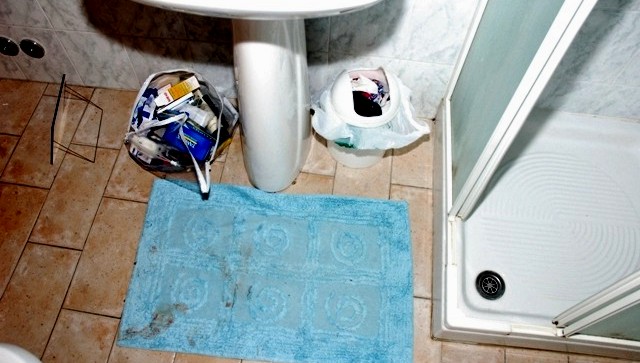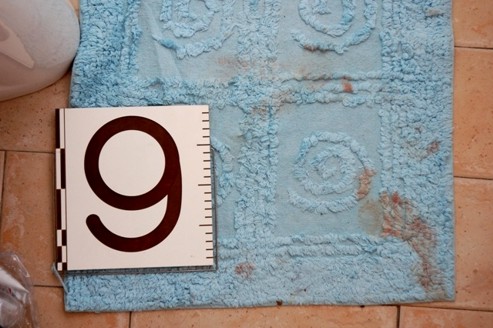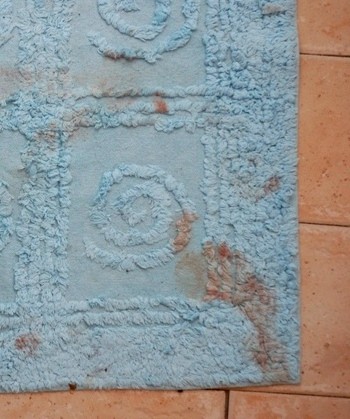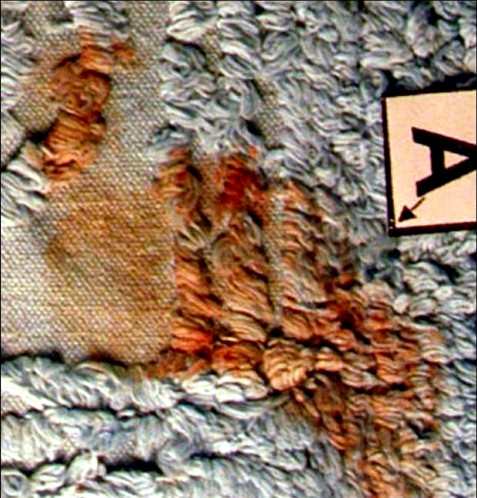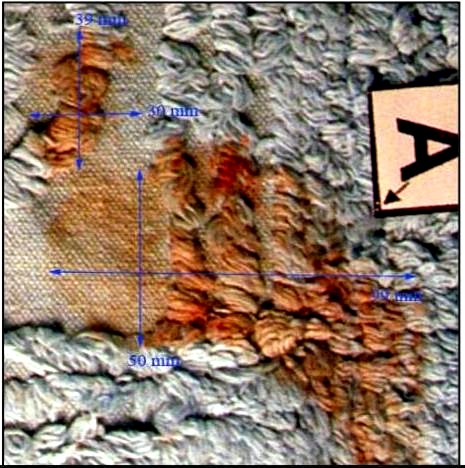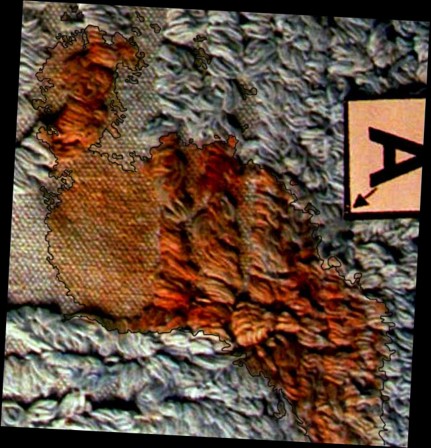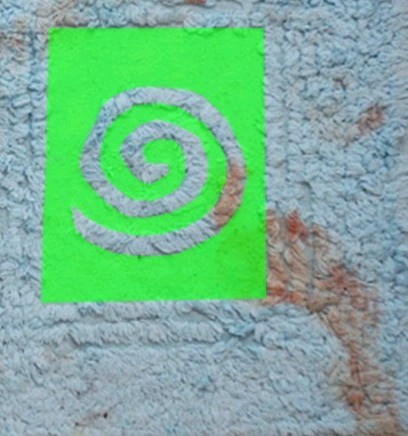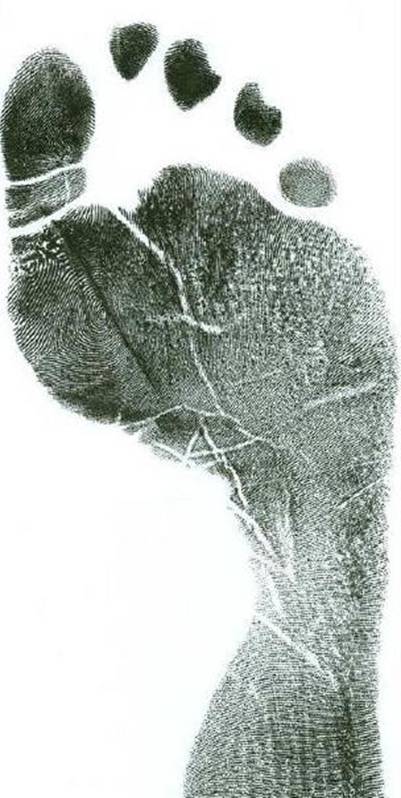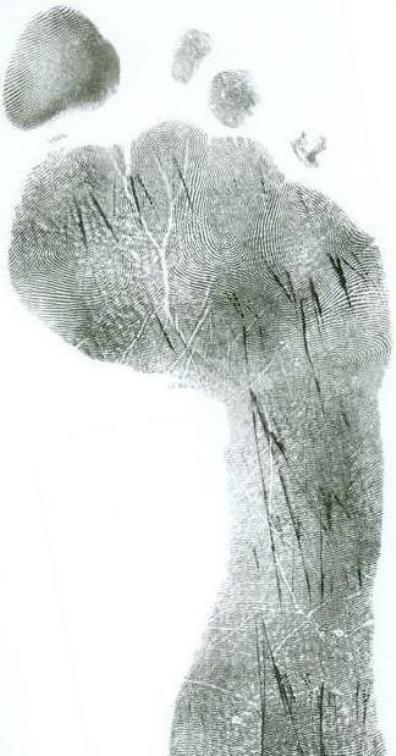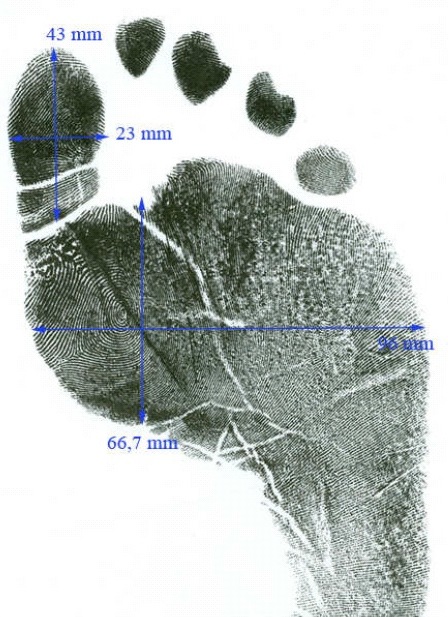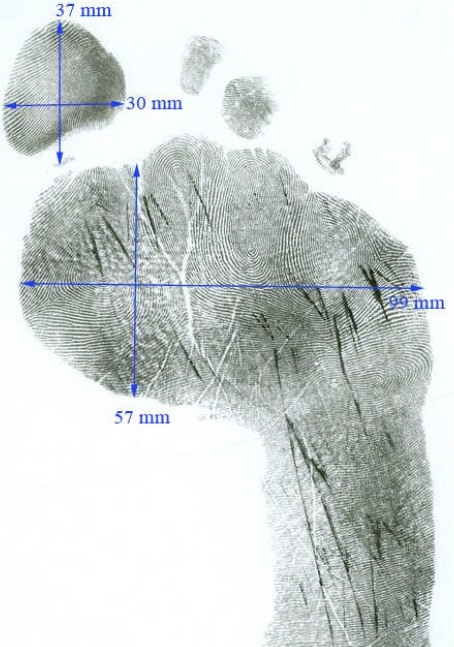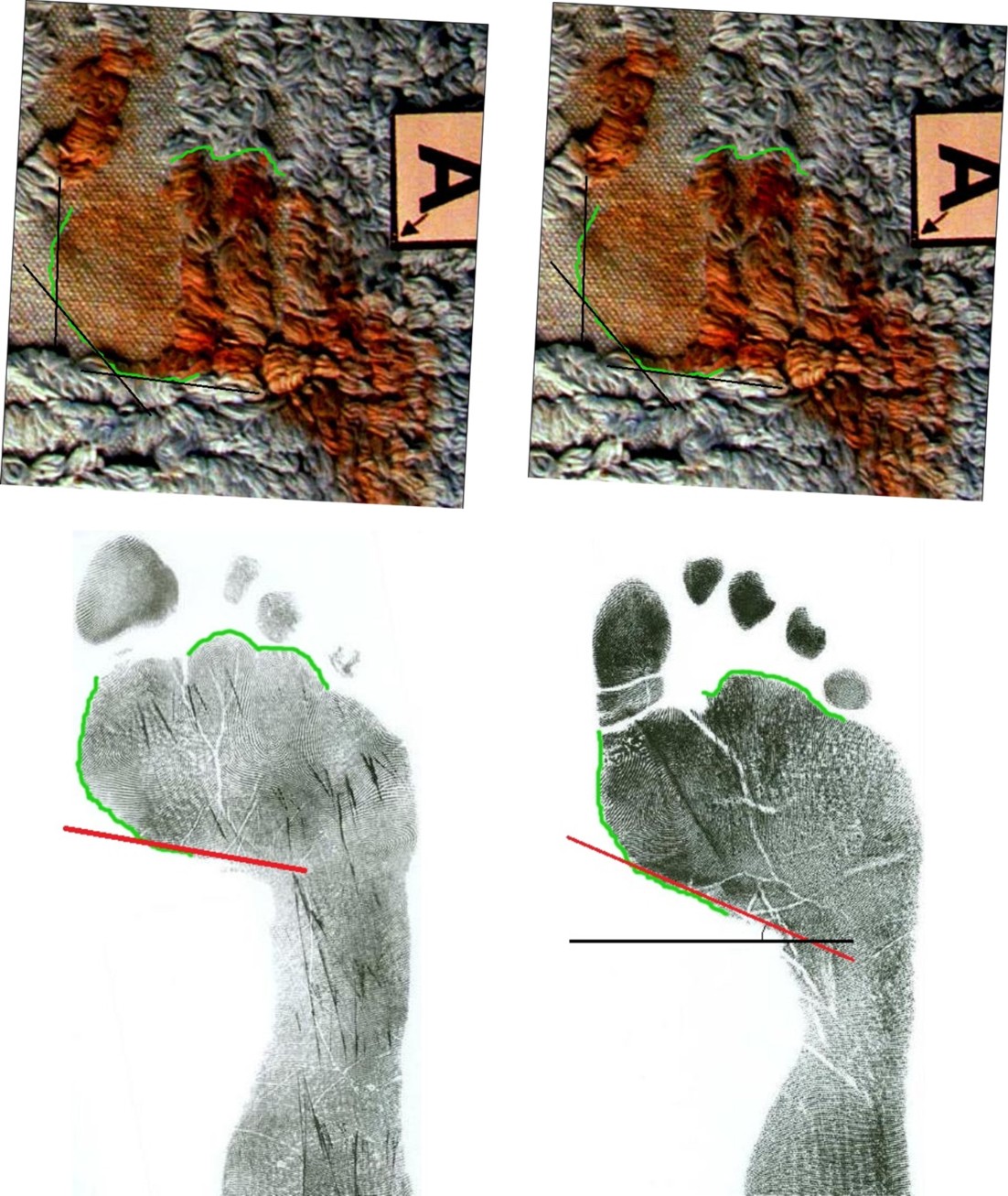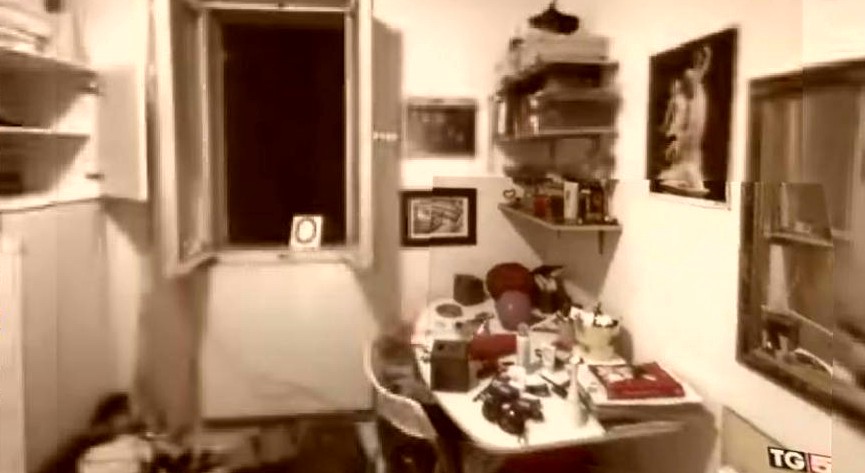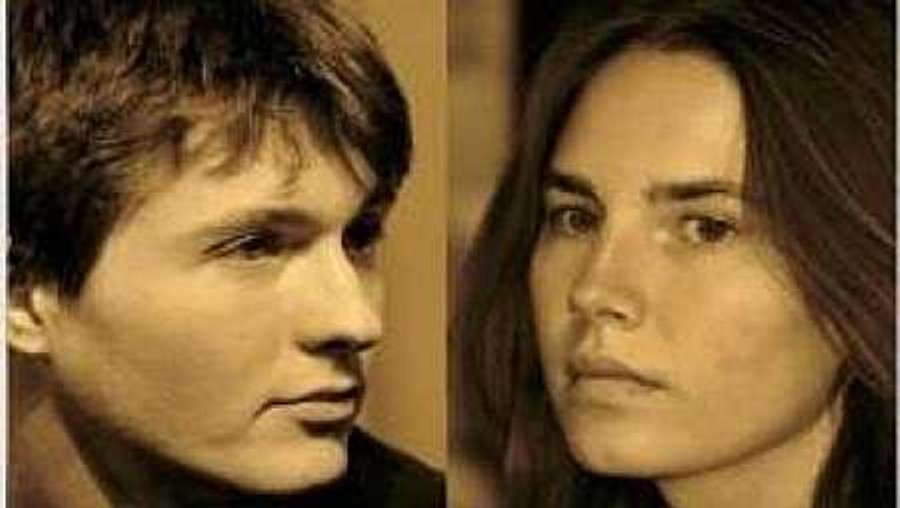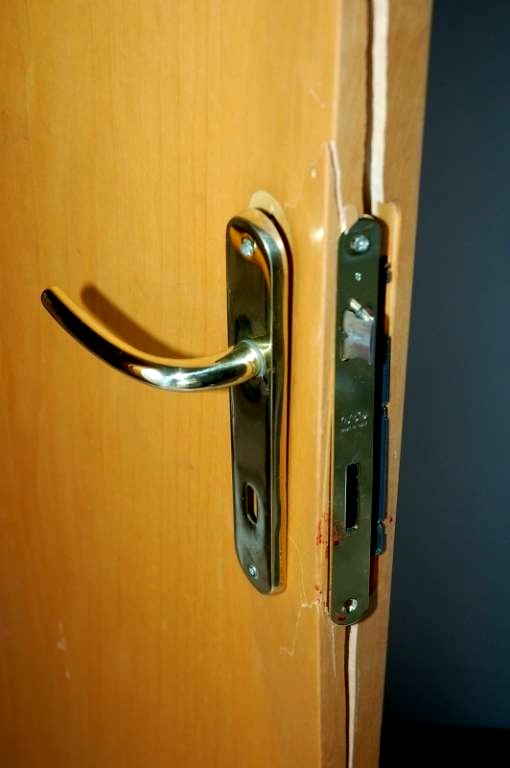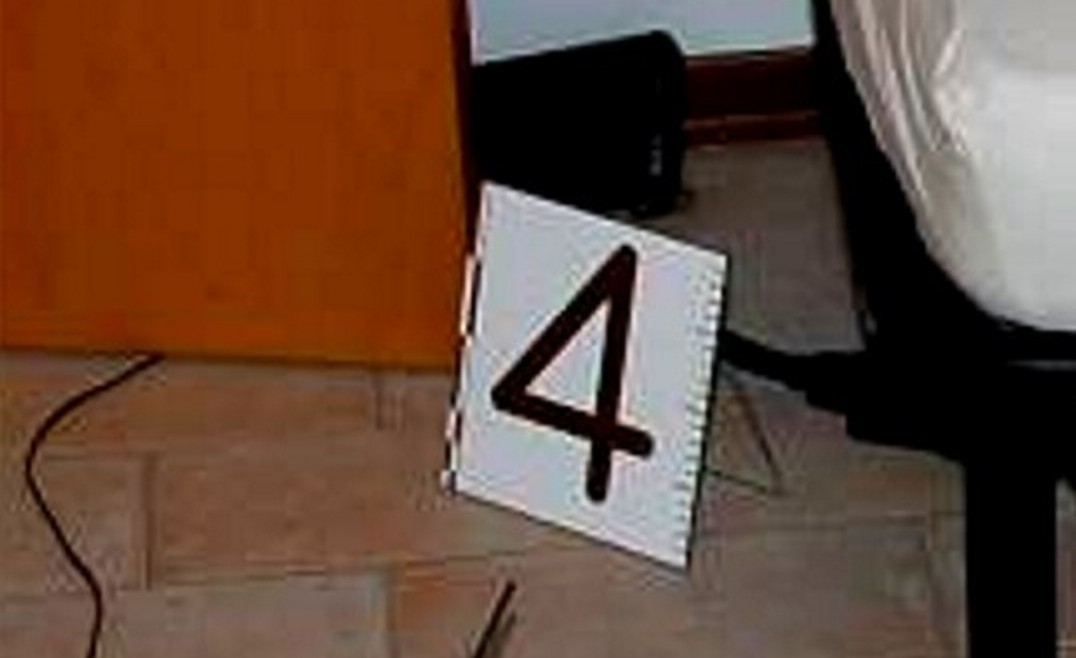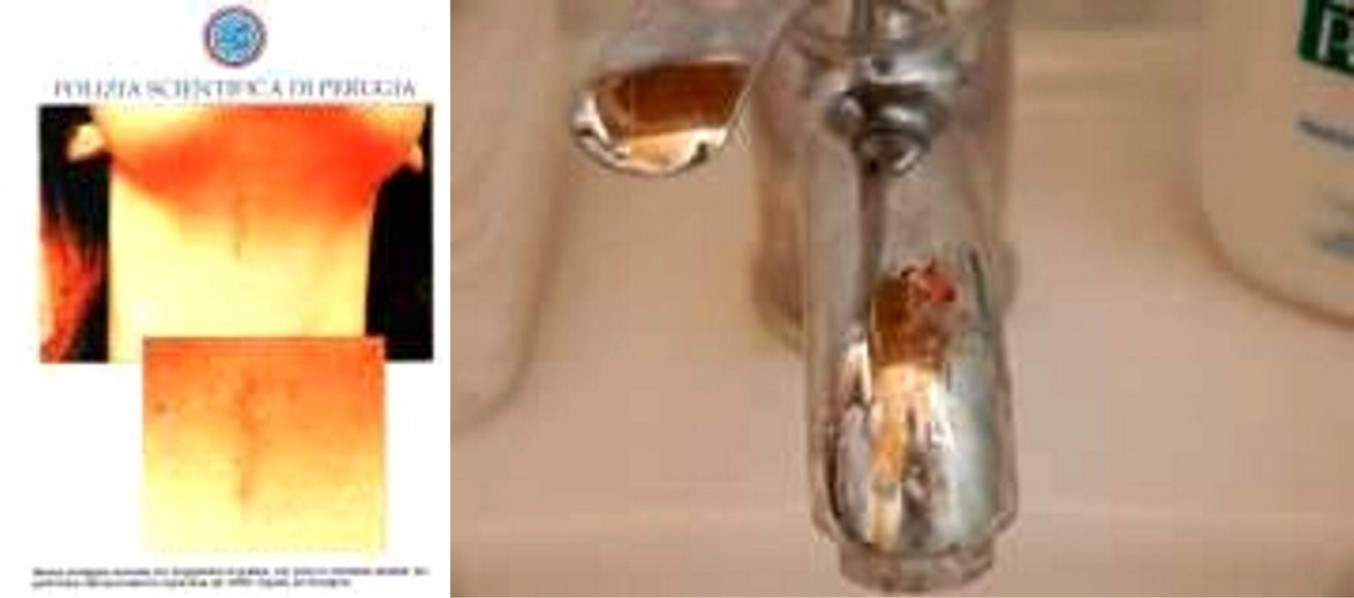
Political & economic headsup: US is demonstrating unsorted systems problems in spades. Do watch your investments. As Washington DC policy gets more & more off-target, big New York investors are betting very heavily that stocks will soon crash. Gross systems mismanagement 2017-20 tanked stocks several times.
Category: 6 No staging hoax
Wednesday, April 16, 2014
The Incriminating Bathroom Evidence: Visual Analysis shows the Footprint IS Sollecito’s
Posted by Machiavelli
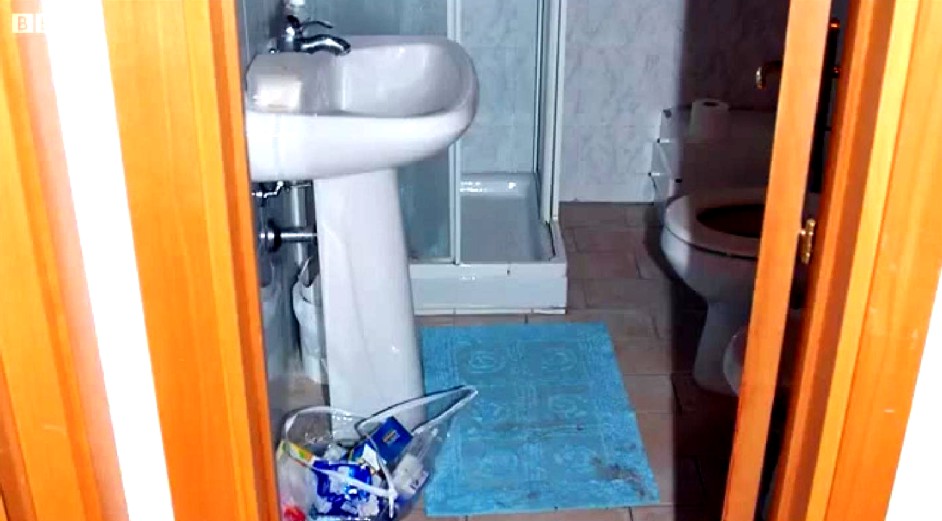
[Please click on each image for a larger and more high-resolution version]
The sheer depth and width of the hard evidence
The defenses really don’t want you to know this: in both width and depth, the full panoply of the evidence against Knox and Sollecito is absolutely overwhelming.
As we remarked in our post below there are far more and far stronger evidence points than UK and US courts normally require for conviction. But only the trial panel of judges observed anything like their full array.
The 2010 Massei Trial Report (which the Nencini Appeal court validated this past January) is a SUMMARY of what was presented to the judges in the courtroom. Those presentations in court were in turn something of a SUMMARY of the hard evidence buried in all the evidence files and the minds of witnesses.
Italian media SUMMARISED for Italians what was to be seen in the courtroom and to be read in the Massei Report. They were barely able to do even summaries for the 1/4 of all the trial hearings that were not open to the media or the public.
UK and US media for the most part didn’t even bother to provide comprehensive summaries (the very fine on-the-spot reportings of Andrea Vogt, Barbie Nadeau and Ann Wise were the main exceptions).
So in effect people in the UK and US attempting to follow the story didnt for the most part receive even a summary of a summary of a summary!
Not one US or UK newspaper or TV network translated the Micheli Report, or the vital Massei Report, or the Supreme Court appeal, or the Supreme Court outcome - only the (mostly professional) translators on PMF dot Org did all that translation.
This post is another example of how far down - beyond even Massei - it’s possible to drill into the evidence, and see it still hold up.
Some past posts on TJMK drilled down to similar depths, on the knives, on the DNA, on the mixed-blood traces, on the phone-events, on the motives and psychologies, and so on. All that evidence too all held up.
Visual analysis of the bathroom-mat footprint
This post mainly consists of high-resolution pictures and measurements. Presented like this, the pictures and measurements largely speak for themselves, and show the real strength of the bathroom-mat footprint evidence.
You will see that as SomeAlibi previously concluded using other methods, this footprint was quite undeniably Sollecito’s. It bears no similarity at all to Rudy Guede’s.
Please click on all images for larger versions in scalable PDF format
1 . [Below] the bathmat and the print, with measurement reference
2 . The bathmat print and the surrounding area
3 . The bathmat print (photo from Polizia Scientifica).
4 . The bathmat print, with vertical and horizontal sizes, from Rinaldi’s report
5. The bathmat print, photo with enhanced contrast.
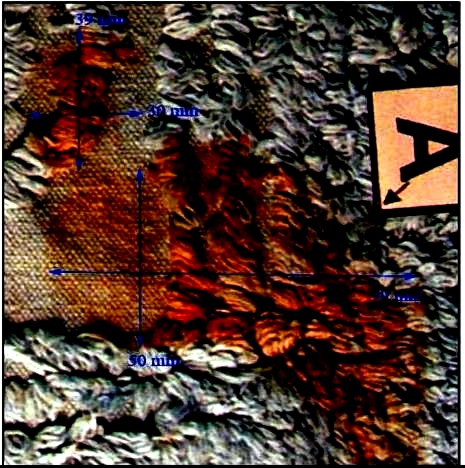
The photo above was modified by highly enhancing contrast.
6 . Enhanced contrast helps to spot some features
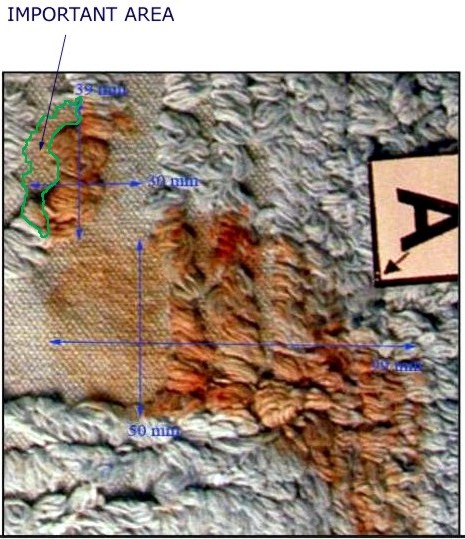
Contrast may help to highlight especially some parts of the print outline.
For example the area on the left labeled as “important area” in the picture (which was “forgotten” in the notorious photo elaborations disseminated by the ‘Friends of Amanda’ group), shows the actual left outline of the “˜big toe’ of the bathmat print.
The toe includes the area indicated in this picture (here the picture is shown again in its original colours).
7. The bathmat, with enhanced contrast
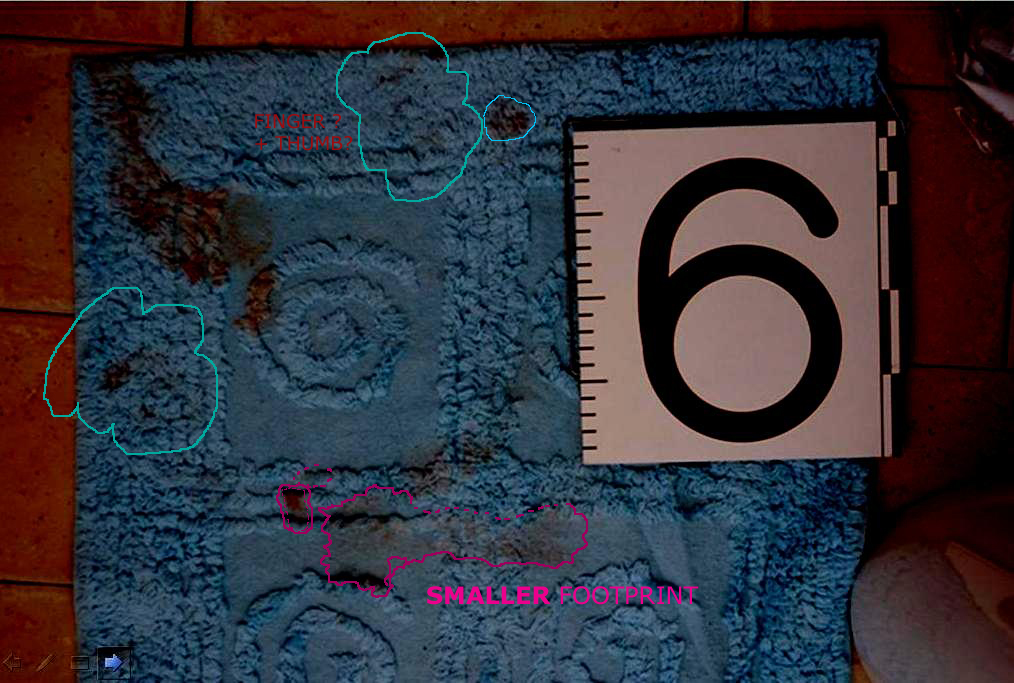
The contrasted image is showing the presence of other stains
There are other stains on the carpet (about another 10, factually situated in one half of the mat area), and also there shows a second diluted footprint (apparently from a foot of smaller size).
8. The selection of a set of red colour shades, outlined by an automatic outline generator
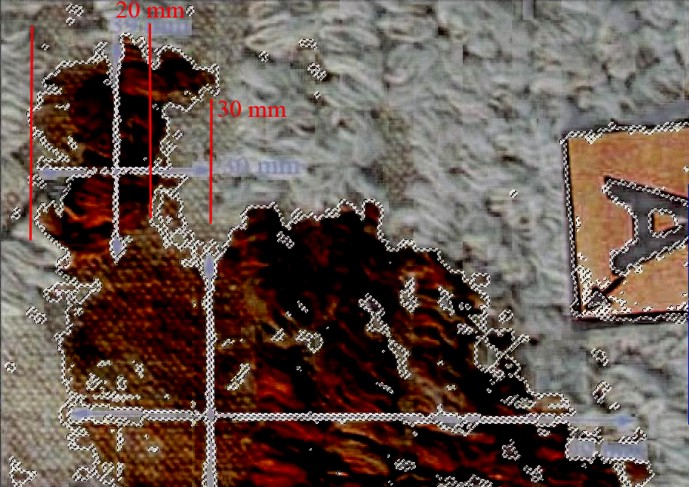
Shows the shape and the possible “˜outline’ of the stain
Reference measurements indicate the width of the “˜big toe’ in millimetres.
9 . A hand drawing of the outline (detail).
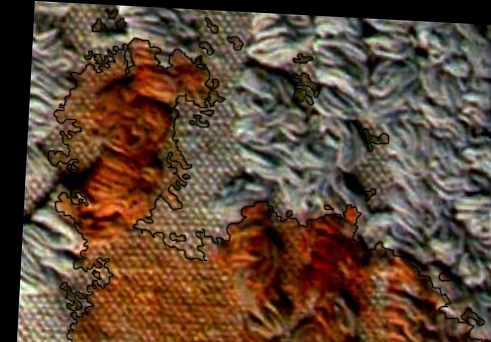
The photography above was modified
The modifications are: +28% contrast, -8% luminosity, + 20% colour saturation, from the original.
An outline has been drawn manually on the photoshop image, trying to be as faithful as possible to the actual stain.
You can notice that, apart from some minor “˜disputable’ very faint areas (such as the area between the toe and the metatarsus) there are only minimal differences between an automatically generated outline and a manually drawn one.
The shapes of the “˜big toe’ are extremely similar in both contours (images 8 and 9), in fact all meaningful features are basically identical.
We consider this manually drawn outline as good for comparison.
10 . The complete hand-drawn outline
11 . Minor detail: small dots separated from the main stain

Observe the small red ‘dots’ in the picture above
Although we can’t draw any conclusion about their possible significance, we note the existence of these very small “˜spots’ of a faint red colour shade, separated from the big stain.
They are detected by the computer generated outline above, and that we also see as distinguishable with the naked eye thus we considered them in drawing manually the outline.
We don’t draw any conclusion about them; but because of their sensitive position (they may suggest a “˜small toe’ mark) we take note of them.
The green arrows in the picture point out their position (green circles).
12 . An image in electronically modified colours
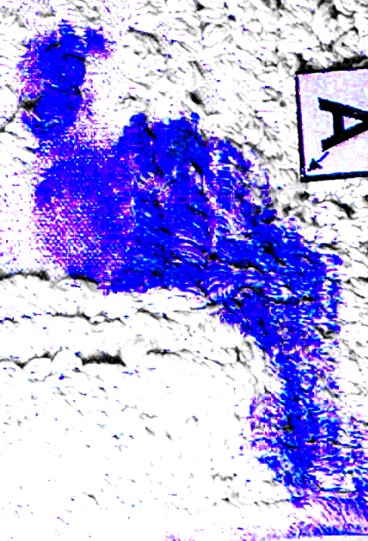
Distribution and intensity of the colouration
As a part of the preliminary study of the stain, we also produced this image above where the computer assigned an artificial colour to an array of shades of ‘red’, thus allowing to further isolate the stain from the background for further assessments about its shape.
This picture shows the distribution and intensity of the colouration. (note: the existence of some above mentioned tiny marks is recorded by this technique too)
13 . The bathmat has a spiral-shaped relief decoration
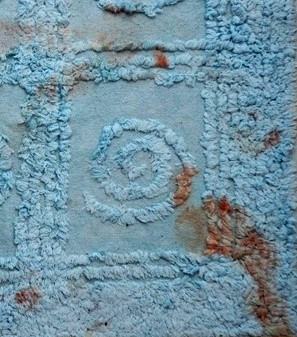
The footprint’s toe obviously balancing on top of the relief decoration.
We think the outline of the “˜toe’ mark of the bloody footprint is affected by the shape of the decoration, in particular the missing part of the toe on the right side, which is remarkably coincident with the margin of the decoration.
So that on that side there is a striking correspondence between the outline of the “˜negative area’ ““ the fabric surface around the spiral, which is lower ““ and the big toe’s outline
This indicates that the outline of that mark on that side was affected by the decoration margin, thus the print there has a “˜missing part’. So the “˜crooked’ bloody area in fact follows the margin of a larger toe.
Because of such coincidence, we can logically assume that the actual shape of the big toe mark appears to be part of a big toe, with larger surface which left its print only partly because part of its surface did not have contact with the fabric, in correspondence of the “˜negative area’.
14. The “negative area”
15. Mat decoration in relief and the toe mark
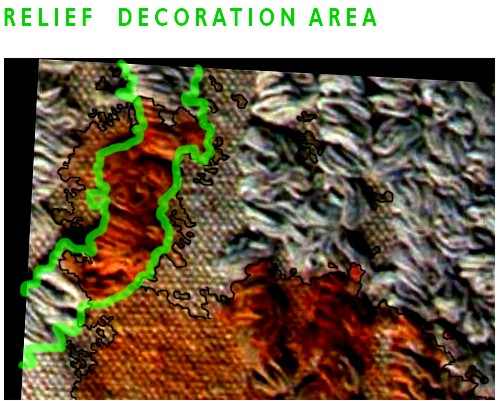
Observe above one single, unitary stain
The remarkable coincidence between the outlines of the decoration in relief and of the toe mark is shown in the picture above.
The rough contour of the print obtained through a smooth curve highlights the shape of the big toe.
Part of the relief decoration outline coincides with the toe mark outline, which shows, highlights and explains how all parts of the red toe mark, that you can see left of the relief decoration, they all belong to one single, unitary stain.
Thus we can deduce that the “missing” area on the right of the toe is determined by the decoration, and coincides with the negative area.
16. Picture (by Kermit) showing a rough shape of the stain
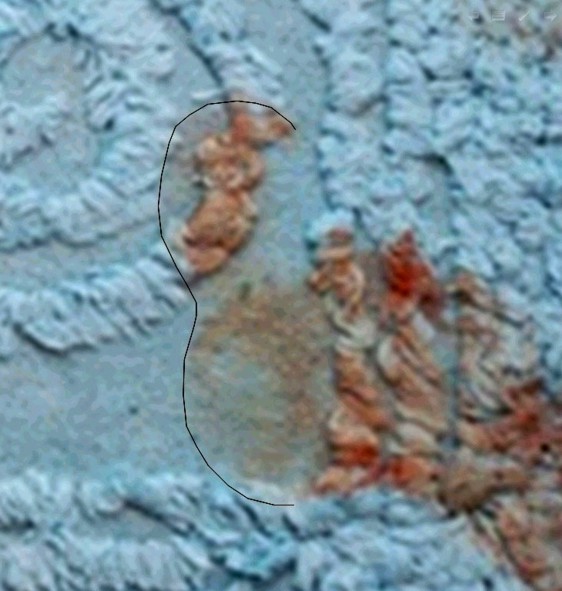
Observe shape, curvature and size
This drawing by Kermit above highlights the rough shape, curvature of left margin and overall size of the big toe.
17. Rudy Guede’s sample print
A copy of this picture together with one of Sollecito’s print at the same scale will be used for comparisons.
18 . Raffaele Sollecito’s sample print
A copy of this picture together with one of Guede’s print at the same scale will be used for comparisons.
19. Part of Rudy Guede’s sample print with Rinaldi’s reference measurements
20. Part of Sollecito’s sample print, with Rinaldi’s reference measurements:
21. Bringing all photographs down to the same scale
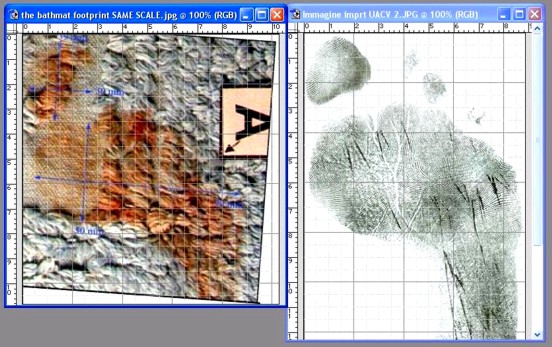
An accurate exercise of scaling was done
This was based on Rinaldi’s referenced pictures. Each one of the Rinaldi’s sample pictures has multiple measurements on several points of reference which allow a high precision determination of their scale and sizes, and thus comparison at the same scale.
In order to further increase scaling precision, the scale was calculated previously and separately for each comparative measurement in the three photos; this was done multiple times for each measurement and the average was picked in order to reduce error as for statistical measurement method.
The resulting final error in the scale is extremely small, far below a threshold of significance that could affect comparison (which was set arbitrarily at 1%, but it’s probably significantly higher, while the actual error is much lower).
In other words, the scale error that may affect your screen pictures will be definitely smaller than any possible perceivable (either significant or tolerated) difference that would be noticed or that may affect the attribution of the stain, when this is compared to the sample.
22. The hand drawn outline is shown again here
23 . The outline (matched scale) overlapped on Sollecito’s sample footprint
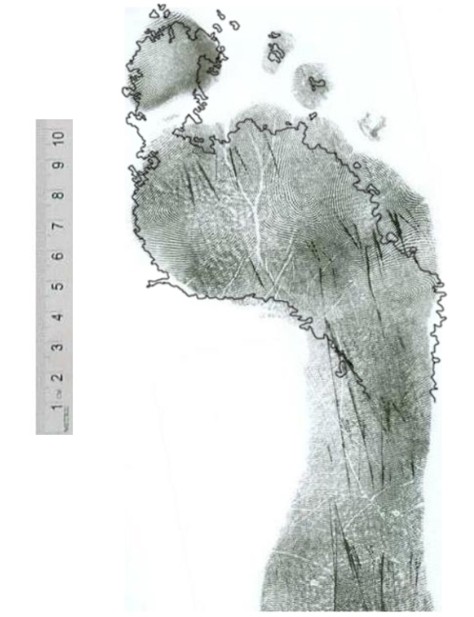
The array of compatibilities with Sollecito
The bathmat stain does not seem to have major incompatibilities with Sollecito’s print; it shows rather an array of compatibilities that can be perceived visually.
One interesting feature is the shape, size and position of a ‘big toe’, that appears as a remarkable coincidence; the toe also has a kind of cleft (see 28 below) on the curvature of its left margin. Another outstanding coincidence is the curvature of the plantar arch on the left.
24 . The same outline overlapped on Guede’s footprint
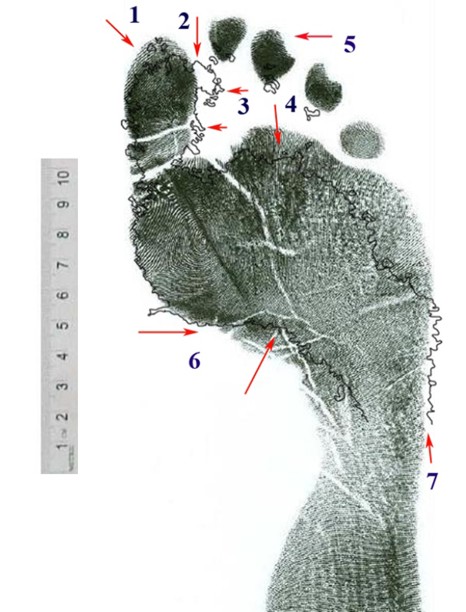
Compare with Guede’s - matched scale.
If you look at the overlapping of the stain outline (see pic 22.) with the sample of Guede’s print (see pics 17. 19.), you may notice 7 major differences, showing a failure of compatibility. Those differences are indicated by numbers (1-7) in the picture .
Each one indicates an area of major difference between the outline of the bathmat stain and the outline of Guede’s sample print. Those measurement differences are remarkably larger than those that can be detected on the overlapping with Sollecito’s sample print.
On the other hand, the compatibility between Sollecito’s print and some very peculiar aspects of the bathmat print (such as a 30mm wide and short toe) were absolutely remarkable.
The differences between the bathmat stain and Guede’s print are :
1) Toe mark of stain is significantly SHORTER than the big toe in Guede’s sample print (a difference of about 7 millimetres). Some people may want to attempt an objection, by suggesting that such a difference may be just a consequence of the position chosen for the overlapping, that maybe the bathmat print was just positioned too low in the picture, the problem may be solved by shifting it up about 7 millimeters so as to make the tip of the bathmat toe ‘coincide’ with the tip of Guede’s print toe.
However, such objection wouldn’t work; it’s a wrong argument. In fact the only possibly correct position for overlapping the bathmat stain outline is determined by the left curvature of the ball of feet and plantar arch (the area of the picture near number 6), which is by the way the most clearly outlined part of the bathmat stain. If you shift the bathmat stain upwards, the outline will miss the match with the curvature of the left margin of the ball of the feet. You will notice that the plantar arch in this area is already very incompatible with Guede’s plantar arch. It tends to become even more incompatible the more you shift the bathmat stain outline towards the toe.
The problem has no solution, since the more you shift the stain outline upwards (in the direction of the toe) in an attempt to make it look more ‘compatible’ with the length of Guede’s toe (or with an upper margin) the more it will become incompatible with the plantar arch. In order to limit the incompatibility of the plantar arch, and in order to keep an overlapping of at least the left margin of the ball of the feet, you need to place it as shown in the picture, this is the position of ‘maximum’ compatibility between the bathmat stain and Guede’s print. Conclusion: the bathmat toe is too short.
2) Toe mark of stain is TOO WIDE (30 mm). It is much wider (30 mm) than Guede’s toe. The number 2. indicates the protruding mark at the upper right, the mark which Giulia Bongiorno desperately insisted on calling a “second toe” mark. In fact, not only would the mark miss completely any hypothetical Guede’s ‘second toe’ in any possible position of the print; also you may notice (highlighted by pics 8. and 9.) how it is not a “mark” itself, but actually it just part of the same area which is entirely continuous in shape and coloration with the rest of the toe mark, and - the most remarkable feature - its right outline is coincident with the outline of the spiral-shaped relief decoration, so that you can reasonably conclude that it is determined by that (the missing area at the lower right of the ‘big toe’ is determined by the existence of the “negative area” of the bathmat decoration).
Conclusion: the bathmat stain has a wider toe mark, however one likes to call it (“big toe”, or “big toe + second toe”) that fails to match any possible part of Guede’s print. The bathmat print is clearly different and incompatible with Guede’s print. It simply cannot be overlapped to any part of Guede’s sample print. Such area is a very significant difference that points outright to incompatibility between the stain and Guede’s print.
3) The toe mark is larger also in the area located at the lower portion of the toe. The toe of the bathmat print in fact has a ‘right margin’ which actually has some additional small marks, small drops protruding towards the right, like droplets maybe produced by the wet cotton fibres of the part in relief which protrude towards the right. This tends to suggest the toe area of the stain may in fact be considered wider: the object that produced it was definitely wider than 22mm, in this area of the toe as well. So also a look at this area confirms that the bathmat stain is wider than 22-23 mm (more towards 30 mm) not just when measured at the upper corner (number 2.) but also at its “lower” parts; here, the small marks caused by the liquid suggest that a larger surface has squeezed liquid from some fabric threads leaving some trace also on the lower area.
4) Bigger incompatibility of Guede on the metatarsus front outline. This area is the front outline of metatarsus: the stain is almost 1cm shorter than Guede’s metatarsus. This happens when you chose the overlapping so as to make the left outline and plantar arch (6.) of metatarsus coincide, as in the picture. Sollecito’s sample print also shows some difference from the stain in this area (pic. 23.) but the difference between the stain and Sollecito’s print is significantly smaller than what you can see in Guede’s print.
5) There are NO SMALL TOES in the bathmat stain. Small toes are completely absent from the bathmat stain (while the tiny blood marks around the stain don’t coincide with their expected position if it was Guede’s print). Such lack of small toes is a peculiarity of the bathmat print. This is a remarkable difference from Guede’s print, and at the same time, a considerable analogy with Sollecito’s print. In fact one outstanding feature of Guede’s print is the evidence that Guede places a big load of weight on his small toes while instead Sollecito has a posture with a weight distribution with the contrary tendency, and obviously he almost does not touch the ground with his small toes.
Thus, Guede’s small toes are all very well pressed on the ground and thus, we can reasonably infer they are somehow naturally likely to get wet if he steps on any wet surface, and anyway they should get wet for sure if the foot is immersed in water or washed (the foot that left the bathmat print must have been immersed in bloody water). The murderer supposedly washed his foot then stepped on the bathmat. In order to attribute the print to Guede we should assume that Guede “forgot” to touch the carpet with his small toes (while instead he puts a lot of weight on them) or that he managed to not rinse them.
6) The outline of the stain has a PLANTAR ARCH that COINCIDES, by curvature and angle, with the plantar arch in Sollecito’s print, while instead it is very different from the plantar arch of Guede’s print.
7) The stain is larger than Guede’s print metatarsus as visible in the right area of the stain. The difference is rather significant, almost half a centimetre, that is bigger than the difference with Sollecito’s print which instead coincides for a trait. This difference cannot be “solved” in any way since, even if one wanted to claim that the scale is wrong and that the stain should be sized down, this would make the toe, already too short (as in 1.) become even shorter.
If instead the toe length is adjusted the metatarsus becomes even less compatible with Guede. We recall that Massei found that Guede’s feet had a print overall more slender than Sollecito’s.
25 . Other features:
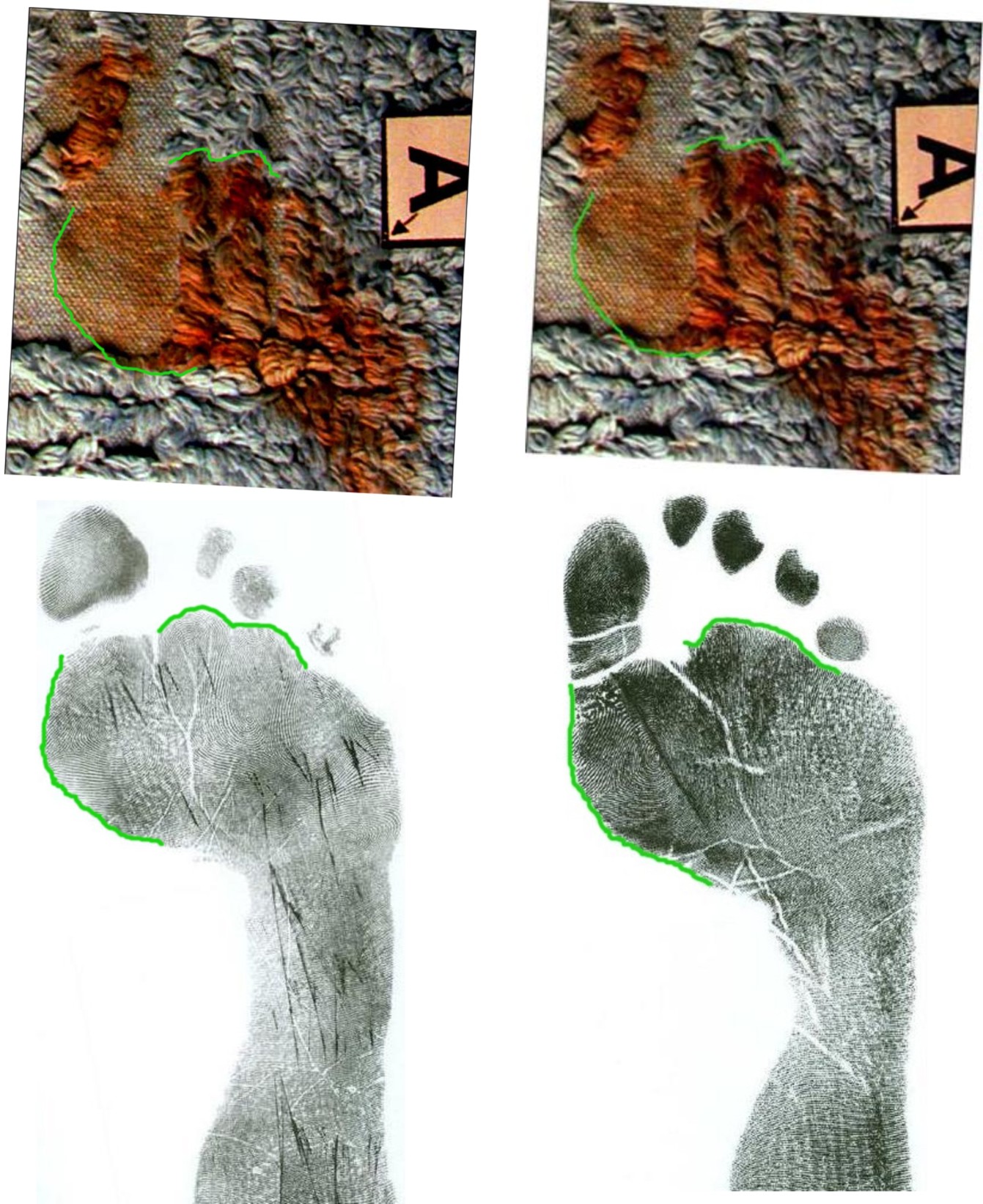
Curvatures of plantar arch are very different
The plantar arch curvature, highlighted in two different drawings (the second highlights also the upper outline “hunches”); the plantar arches in the two sample prints of Sollecito and Guede are shown below. The curvatures of plantar arch are very different.
26. The outline curvature generates different angles
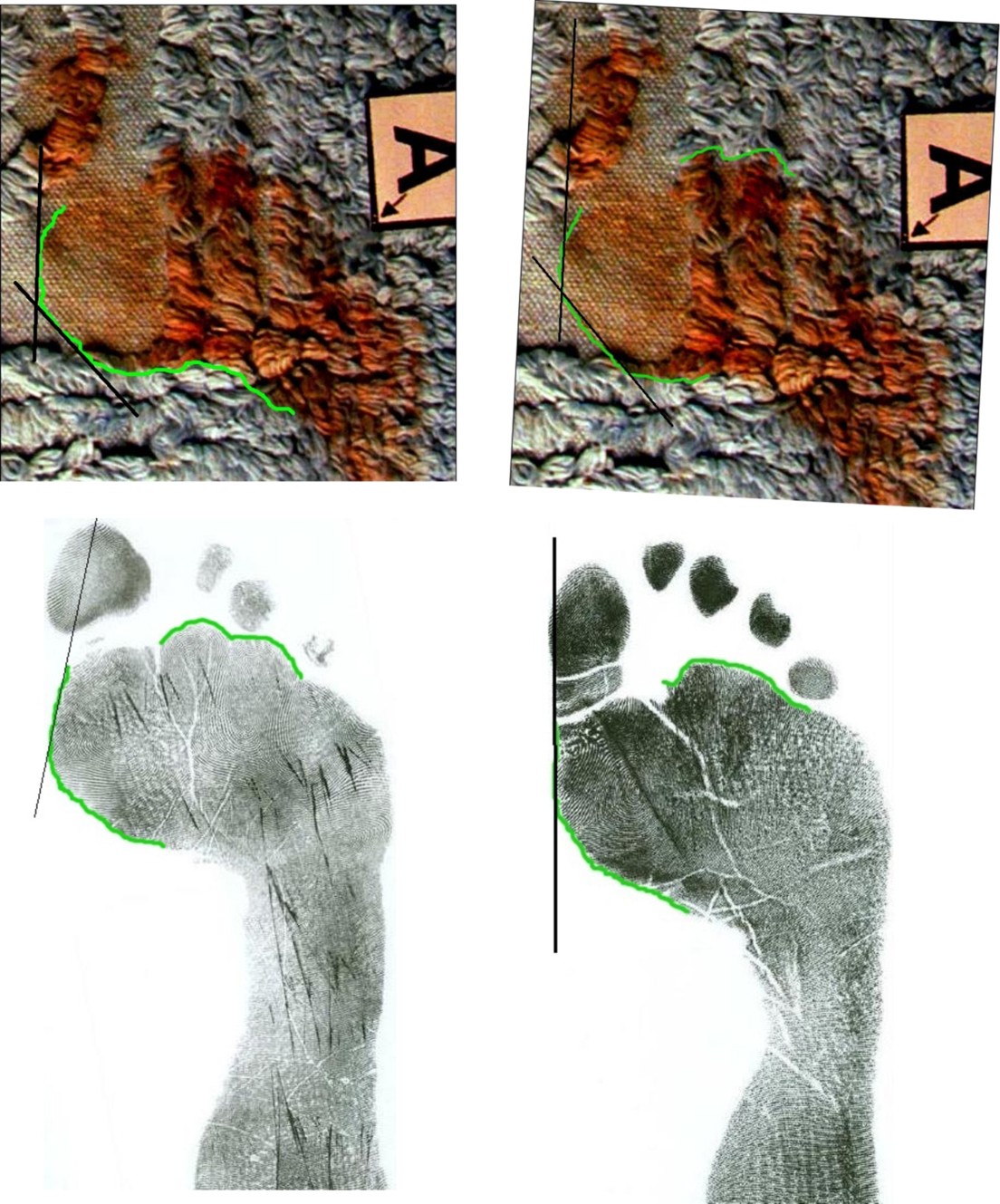
Sollecito’s and Guede’s plantar arch curvatures have very different angles. Also the left outline of metatarsus maintains a different curvature. Sollecito’s outline has an angle (see outline tangent) intersecting the toe (the metatarsus has a “bunion”); in Guede’s print there is basically no intersection, the outline and the toe form almost a straight line.
27 . Plantar arch curvature angle differs between Sollecito and Guede
If you consider the vertical axis of the sample footprint, and its orthogonal line, you may notice how the plantar arch curvatures of the two prints accomplish different angles: the two angles are VERY different, not just three or four degrees.
The (too) narrow angle of Sollecito’s plantar arch probably has a relation with the protruding outline and angle seen in pic 26., and seems related to a hallux valgus (which Guede does not have).
28 . The “cleft” on the left side of the stain
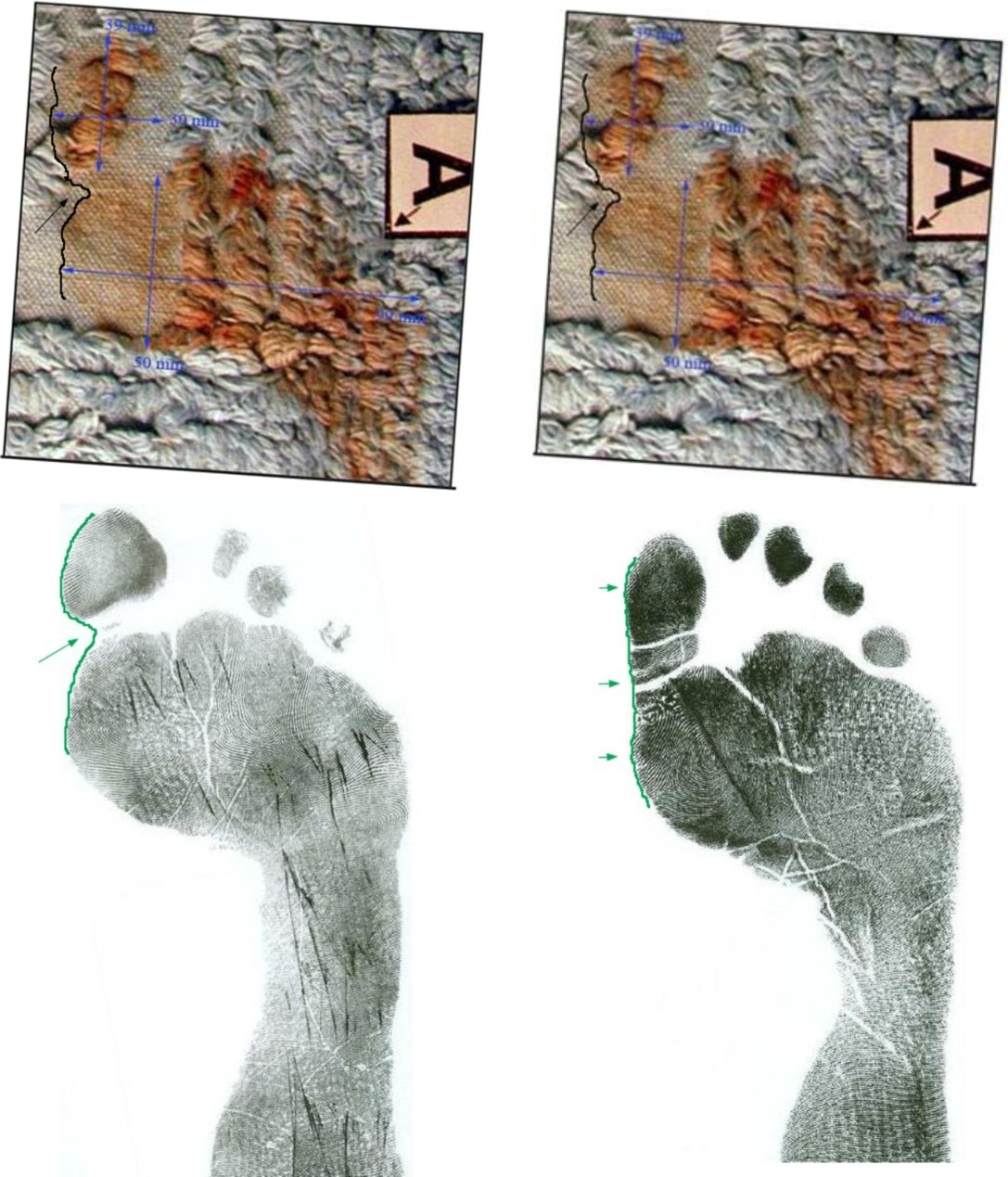
The “cleft” on the left side
This has a correspondence with one sample print, not so with the other.
29 . Table of metric comparison (by SomeAlibi)
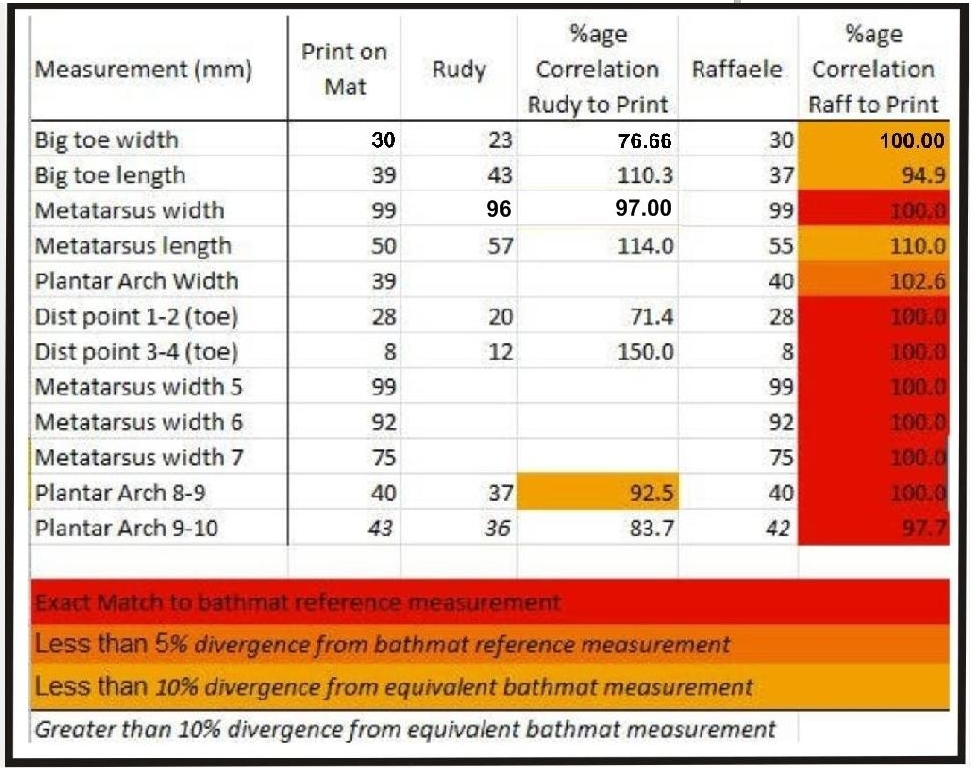
SomeAlibi’s post of a year ago
Comparison of measurements and analysis of correspondence degree of bathmat print, with both Guede’s and Sollecito’s sample prints.
Tuesday, February 11, 2014
The Much-Demonized Rudy Guede Is Back In The News And Increasingly Threatening
Posted by Peter Quennell
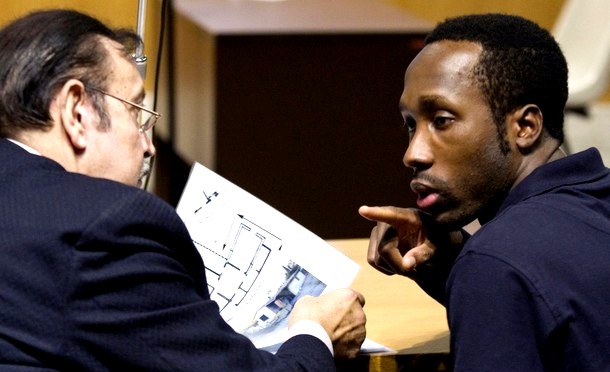
Rudy Guede has long DELIBERATELY been demonized so that the attack on Meredith can be assigned to him alone.
This description of Guede’s early days in the Ivory Coast and Perugia in the excellent Darkness Descending by Paul Russell and Graham Johnson remains the ONLY one that fully checks out. Certainly not that by the dishonest PR shill Nina Burleigh.
Guede wasn’t especially an angel, and some in Perugia were iffy about him. But he had real friends, and up north he held a real job with a real career future, until that prospect imploded and sent him haplessly back to Perugia.
Late in October 2008 Judge Micheli discounted all that Guede ever said about his role in the attack on Meredith in various conversations and statements, and sentenced Guede to 30 years.
But Judge Micheli also concluded that there was no firm evidence either that Guede acted alone or that Guede was a drifter, drug dealer, knife wielder or burglar (Micheli was very sharp with one witness who claimed Guede may - may - have broken into his house).
In 2009 through his lawyers Guede enquired of the prosecution whether he might testify at the Knox-Sollecito trial.
But the prosecutions’ hands were already tied by the indictments and they (rightly) believed they had a really strong case regardless of anything Guede could add.
At the 2009 trial the defenses pussyfooted around and never settled for a firm position on Guede. They floundered in their subdued attempts to prove that Guede or somebody else unknown was the so-called Lone Wolf.
The Lone Wolf theory is really a zombie theory with so many stakes through its heart that no court will ever take it seriously.
Guede’s steadfast fallback position before and since was that he was only in the house on the night of the attack because Meredith invited him to come in and they began love-making.
At his late-2009 first appeal and also at Sollecito’s and Knox’s 2011 appeal before Judge Hellmann, he increasingly firmly pointed the finger at Knox and Sollecito as the murderers.
Guede had been initially inclined to let sleeping dogs lie after he was mysteriously beaten up in the sex offenders wing of Viterbo prison, where prisoners are meant to be kept very safe.
But Judge Massei’s scenario of the attack on Meredith in his March 2010 Sentencing Report, with Rudy Guede as the lead instigator, really bothered him.
And in mid 2010 he became even more bothered when claims were made by a fellow prisoner the baby killer Mario Alessi that Guede confided that he really had committed the murder, along with two others. Not with Knox and Sollecito.
A very angry Rudy Guede in turn wrote a letter denying this which very rapidly went public.
In 2011 there was a tense confrontation in the Hellmann court (which several times descended into chaos) when this letter, in which by now Guede firmly accuses Knox and Sollecito, was read out for him.
Guede stuck to this position on the stand, and he was not required to face full cross-examination by the shrill, frustrated defenses because he was already convicted and no longer the one on trial.
Seemingly fed up with all the dirty tricks against him and the now-incessant Knox and Sollecito mantras in the media that Guede had acted alone, he has come out with another letter.
Italy’s AGI News Service has posted this letter to an unidentified recipient, along with this report.
(AGI) Perugia, February 11 “Against me are being repeated false imaginated reconstructions of the crime for the sole purpose of wanting to denigrate my figure and person, systematically and in a negative way, in the public eye and not just in Italy.”
He apparently also posted what he wrote in his own hand on the Facebook page “Legal processes and their surroundings”...
The letter is on a sheet of notebook paper handwritten and signed by Guede.
“To my regret I am again forced to take a pen and paper and write for the sake of the truth.. to all those thousands of people who still believe in justice.”
“They can not access all the pleadings and components of this sad and extremely complex legal case which was dramatically painful for those who lived it . My sentence and judicial reasoning have been for too long subject to a continuous and willful manipulation and alteration of the data of the proceedings.”
“Against me are made continuous false and imaginary reconstructions for the sole purpose of wanting to denigrate my figure and person, systematically and in a negative way in the public eye and not just the Italian.”
“In the final judgment, as far as I’m concerned about these false and imaginative reconstructions, is that I was acquitted of theft and simulation of crime, a fact that I never hear mentioned in the various journalistic reconstructions.”
“I also want to point out I do not accept in any way to be passed off and continually held up as a drifter, a thief, a homeless man, seeing my person and my dignity offended continually, denigrated and stereotyped by facts and things that do not realte to me… when I had a beautiful family and precious squeaky clean and friendly relations in Perugia.”
Fast-forward to today, where reports say that Guede is getting close to day-release for study purposes and may only be months away from making more evidence against Sollecito and Knox public.
Our posting lawyer TomM has looked at the issue of Guede being allowed out to study, and finds it regular and humane in this assessment.
I respect the Italian system of criminal justice. Just as I recognize that the Italian courts have much better information than anyone posting on the internet relating to the culpability of the defendants in this case, I also think that the people who oversee Guede’s stay in prison are better informed as to his fitness to be reintegrated into society. That he would be allowed out during work days to become better educated, returning to his prison cell at the end of the day seems to me a more enlightened approach than what we do here.
We used to have training programs in prisons. I don’t know that they were “cushy”, but they did work, so that when these convicts were released they were equipped with a marketable skill and rarely re-offended. But, the public thinks these were too cushy, so more Draconian circumstances and longer sentences are now the norm. It used to be people were sent to prison as punishment, now they are sent for punishment.
Sometimes when a prisoner who has spent his or her entire adult life in prison completes the sentence imposed, they have to be physically dragged from their cells, so ill-prepared are they for anything other than doing time. With no skills, social or job-related, they re-offend—surprise, surprise. Sometimes re-offense is for the purpose of being returned a world that, for all its dangers is, to them, relative safety.
While it is certainly true that prison doesn’t have much impact on sociopaths, the one thing they are attached to is money. Taking away their money does impact their behavior, so there is an alternative to killing them.
Monday, January 20, 2014
Appeal Session #9: Sollecito Team Concludes, Prosecutor Crini Rebutts Defenses’ Claims
Posted by Our Main Posters
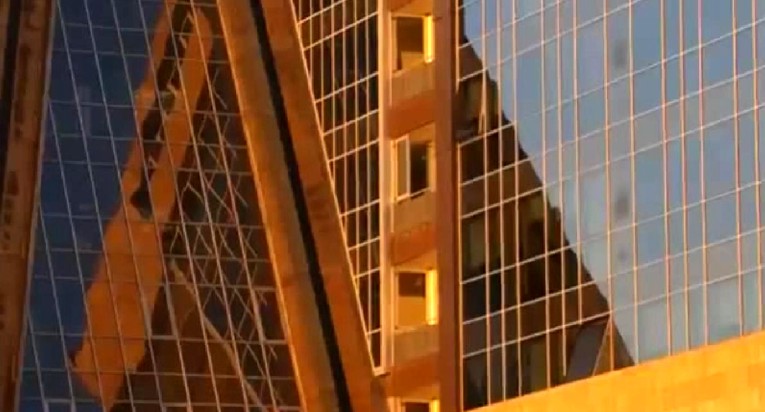
[Above: Sun hits the facade of of one of the most modern courtrooms in Europe]
5. Andre Vogt’s Excellent Post-Court Reporting In The Week
From Amanda Knox’s fugitive fears: she’s right to be worried
Sources close to defence lawyers confide that they, too, fear it may not go their way.
It didn’t help that Knox ignored her lawyers’ pleas to travel from Seattle and attend court in Florence - she sent an email instead - nor that she repeatedly requested to meet the Kerchers, only to be sternly rebutted by their lawyer, who suggested she act more like a defendant.
Then she started a new blog and began blithely responding to comments ““ most recently posting an admission that she had once faked a break-in as an April Fool’s prank before she left for Italy (a staged burglary is a key part of the case against her).
Have the wheels come off Knox’s public relations machine now that she’s safe in Seattle? She may need them again soon, because this appeal differs radically from the first one in 2011 which resulted in her acquittal, but which was harshly criticised and eventually annulled by Italy’s Supreme Court earlier this year.
There are three good reasons why this trial is different ““ and why Knox has reason to be nervous:
First, her co-defendant Raffaele Sollecito’s lawyers have distanced his defence from Knox’s. “He may have brushed her hair and cleaned her ears, but he would not have killed for the love of Amanda,” his lawyer Giulia Bongiorno told jurors in closing arguments earlier this month. “Turn off Amanda,” she said. “Raffaele is not Amanda’s other half.”
Second, the uncompromising Perugia prosecutor Giuliano Mignini has stayed away from Florence. Without him in court as a convenient villain, the “innocent American abroad being railroaded by a rogue prosecutor” narrative no longer holds water. The Florentine prosecutor, Alessandro Crini, has distanced the state’s case from the always controversial kitchen knife that may or may not have been the murder weapon. He’s also given less credence to the “˜sex game gone wrong’ theory that was central to the prosecution case in the first trial. Instead he’s considered all the evidence as a whole. There might have been a fight about missing money and hygiene, he said, but motive doesn’t matter: murders happen all the time for banal reasons. And convictions happen on much less evidence.
Third, the strict Florence judge, Alessandro Nencini, has curbed all antics by lawyers, public and media. There are no perp walks with popping flashbulbs this time. However the appeal ends, no one can argue that this trial wasn’t professionally managed.
4. Tweets by freelance reporter Andrea Vogt
14. Sollecito defense on bra clasp: For us, the condition of the room and conduct of the forensic police tells us there was contamination.
13. Judge interrupted Sollecito lawyer with a booming “No!” saying wiretapped conversations of Sollecito family not to be discussed this trial.
12. Maresca: Whatever you decide, we believe justice will be done & all elements considered in depth. We will serenely accept your decision.
11. Kercher attorney Maresca: Perugians reacted angrily to amanda knox acquittal because it was scandalous: acquittal was decided in advance.
10. Fabbiani, attorney for Meredith’s brother, urges court to look beyond motive. Perna for her sister: one person alone did not kill Meredith.
9. Lumumba attorney Pacelli concludes with this phrase to the jury: “Convict liar Amanda, the diabolical slanderer.”
8. Presiding Judge Nencini has cut Pacelli’s amanda knox monologue short. Says going off track. Pacelli promises to finish in 5 min.
7. Lumumba’s attorney Pacelli is delivering a vitriolic rebuttal on amandaknox - mixing his unbridled contempt w/her own statements.
6. Prosecutor asks (in case of conviction) cautionary measures so defendants can’t flee. Options are: passport, house arrest or arrest.
5. Prosecutor Crini: a lack of motive does not equal proof of innocence.
4. Trial back in session after “pausa caffe” during which Sollecito and his accusers were in tiny court coffee bar at same time. Only in Italy!
3. Sollecito attorney: The only things certain are the death of Meredith Kercher and the presence of Rudy Guede in the house that night.
2. Sollecito attorney: This case is an anomaly. Various judges interpreted facts differently over the years. There’s reasonable doubt.
1. In court, Sollecito attorney Maori contesting prosecutor’s arguments point by point. Knife, bathmat, alibi, witnesses. Afternoon rebuttals.
3. Tweets by our main poster Machiavelli
[At this point Machiavelli signed off]
62. Crini: Nencini asks the clerk’s officer to write down formally the exact terms of prosecution request to issue cautionary measures [if verdict guilty]
61. Crini says his conclusions are unchanged. Prosecution suggests arrest decrees are issued immediately if defendant(s) is(are) guilty
60. Crini points out the crime and motive originate from group dynamic.
59. Crini: Bongiorno had pointed out that anyway Sollecito should be accounted only for what he had done (implicit: not what Knox did)
58. Crini: The excessive and too quick reaction to a situation of rising argument is typical of group reaction.
57. Crini: Argument about cleaning was also reported by Meredith to her father John Kercher
56. Crini: Massive rejection of English [girls] testimonies is “weak” on the part of defence; tensions and dislikes in the house are recorded on paper
55. Crini: Movite cannot be assessed preliminarily as if it was a piece of evidence to be discussed
54. Crini: if you need to prove a crime, it is opportune to detect a motive, but a motive is only a plausible conjecture not basis for deduction
53. Crini: Bongiorno called all English girls ‘unreliable’ (because English, maybe coached by lawyers etc.)
52. Crini calls ‘amusing’ Bongiorno comparing her client with captain Schettino
51. Crini: Some thoughts about the motive.
50. Crini: It makes no sense to say the large kitchen knife is ‘incompatible’ with the big wound.
49. Crini: To the court: can you imagine a ‘surgical operation’ with a small knife producing a wound with clear margins on a live struggling victim?
48. Crini: it is difficult to produce an 8x8 cm large wound with a small 8cm long knife, it would produce at best a wound with irregular margin
47. Crini: The blade hypothesized by defence from the bed sheet stain is anyway larger; these are anyway conjectures. Datum is compatibility
46. Crini: thinking you can preemptively deduce the size of the blade from bed sheet stain is ‘unrealistic’
45. Crini: The “double knife theory” is based on the small size of the right wound, experts point to a likely much smaller knife with thin blade.
44. Crini: no defence wounds, no fight bruises, nothing under nails, bruises indicate forced restraint of victim; how she was immobilized
43. Crini: Massei court did not decide about attribution of pillowcase shoeprints, Crini objects Vinci’s finding, thinks prints are too small
42. Crini: Knox defence: says when Guede leaves palm print on pillowcase leaves a signature
41. Crini: Bongiorno called the murder scene “flooded” with Guede’s DNA. Crini points out his traces in room indicating he had free hands (no weapon)
40. Crini: The defences also dealt thoroughly with the use of the knife, wounds, blade size
39. Crini: The dynamic of the crime. Maori attributed all traces to Rudy Gede alone
38. Crini: All alleles of the victim were found in a scratch on the knife blade. Human DNA is normally not on knife blades
37. Crini: Vecchiotti admitted there was a scratch on the blade
36. Crini: The same defence experts did not object to the attribution Y haplotype of Guede found in the victim’s vagina
35. Crini: Calls Vecchiotti’s reasoning on bra clasp “a priori”, dismissed for reasons totally general and vague. Doesn’t read Y haplot. and X together
34. Crini: Points out a passage where Vecchiotti’s report misquotes police findings inserting the word “only”, built a strawman
33. Crini says let’s look at the Conti-Vecchiotti report, to see what it says, if you can subscribe with the report.
32. Crini: Tagliabracci in 2008 objected to quotes of prof. Gill calling them “too recent”
31. Crini: Objections referred to Low Copy Number are obsolete, and also partly undermined by the RIS report
30. Crini: Calls “embarassing” Bongiorno when alleges the police was wrong in attributing stains to cat’s blood
29. Crini: Disproves Bongiorno’s allegation that the clasp was stepped over.
28. Crini: Novelli rules out there was contamination in laboratory, as well as tertiary transfer in situ.
27. Crini is “pleased” the defence did not attempt to allege laboratory DNA contamination. Points out findings by Novelli
26. Crini: report says had there been internet surfing or writing activity, this would have resulted as obvious.
25. Crini cites arguments about computer expert reports, hearings of 14 Mar 2009 and Dec 2010 say further investigation is unnecessary
24. Crini: Maori omits to quote pieces of Curatolo’s testimony.
23. Crini will deal with Maori’s “theory of alibi” only very briefly
22. Crini says defence arguments on bathmat print are conjectures. Rinaldi is actually same person who correctly attributed shoeprint
21. Crini: Bathmat print: compatibility assessment can be done on what is measurable
20. Crini: Guede knew the hous and apartments, would have chosen logical entries and logical behaviour, Crini calls burglary theory ‘not credible’
19. Crini: alleged small wounds on Guede’s hand, inconsistent with absence of his blood on scene
18. Crini: Talks about Bongiorno’s criticism to staged burglary scenario - the scenario of Guede already inside apartment
17. Crini says police report timings, records of CCTV video camera and phone calls are ‘consistent’
16. Crini does not see corroboration of alleged 7-minute late clock error of CCTV. The 13.29 call was from Carabinieri HQ and don’t change anthg
15. Crini tris to “strain” the timing of police arival to favor the defence, to see if scenario fits. Considers possible CCTV time error
14. Crini: Sollecito calls Carabinieri too late, also because last phone call to Romaneli was at 12.38
13. Crini: Call to Sollecito’s sister, and then Sollecito’s call to Carabinieri at 12.51-45. Crini: this timing is late independently from Battistelli
12. Crini: Battistelli arrives on foot about 10 minutes eariler than postal police car
11. Crini wants to look better at some arguments about Sollecito’s declarations to postal police. Battistelli recalls 12.35 consistent with CCTV
10. Crini talks about Sollecito ‘sidetracking’, talking about statements to postal police
9. Crini: Knox’s Calunnia also contains details that have external corroboration and she could not have deduced from simple burglary scenario
8. Crini: A Calunnia is itself incriminating (require strong defence explanation), but Knox’s Calunnia also contains furth incrimiating details
7. Crini: Knox maintained her calunnia against Patrick over a period of several days. Crini points out the logicality of Cassazione argument.
6. Crini: Knox statements: ‘Patrick had sex with Meredith’ and ‘there was a loud scream’ were new elements, unrelated to known facts and not retracted
5. Crini: On calunnia, Crini points out that there was an argumentation about Knox defence about usability of Knox’s statement. argument is wrong
4. Crini: Theoretically all defense points could be replied to, Knox’s Calunnia, Sollecito statements to police, the staged theft, the mat print; DNA evidence
3. Crini says he will talk briefly only about a few selected points, without repeating himself, and without discussing old arguments again
2. [After the break] Prosecutor General Crini begins to reply.
1. [After the break] Sollecito entering the court, asked what he expect, says “no comment”
2. Tweets by reporter Barbie Latza Nadeau
44. Judge especially hard on Sollecito sub lawyer, reprimanding her for introducing new arguments when she is only supposed to be refuting.
43. Sollecito sub lawyer argues no DNA from Meredith Kercher on bra clasp w/Sollecito’s DNA, failing to mention she was wearing the bra..
42. Six years of Kercher trials and some lawyers still pronounce the K in Knox.. “ka-nox” as Sollecito’s sub lawyer just did.
41. Kercher lawyers finished, now Sollecito lawyers up for rebuttal, but both his principal lawyers had to leave early.
40. Kercher atty Maresca: Perugians reacted angrily to Amanda Knox acquittal because it was scandalous: acquittal was decided in advance.
39. Kercher lawyers ask court to consider all the previous testimony they say proves more than one person killed Meredith Kercher.
38. Lumumba lawyer says his client has not received any of the €22k he is owed by Amanda Knox even though the slander conviction is final.
37. Judge reprimands Lumumba lawyer for veering off course, he is only to discuss slander aspect of case, not murder itself.
36. Lumumba’s atty Pacelli is delivering a vitriolic rebuttal on Amanda Knox - mixing his unbridled contempt w/her own statements.
35. Lumumba keeps referring to Amanda Knox as “the American”, says she had a penchant for drugs, alcohol, sex.
34. Lumumba lawyer calls Amanda Knox a “diabolical slanderer” “¦
33. Lumumba lawyer says Amanda Knox substituted Patrick for Rudy Guede.
32. Court back in session with Lumumba lawyer up. Sollecito back in court after break.
31. Prosecutor Crini: a lack of motive does not equal proof of innocence. Amanda Knox
30. Prosecutor focused on knife, says traces of Meredith Kercher and Amanda Knox are valid.
29. Sollecito staring at prosecutor as he delivers rebuttal, jury taking notes, judge listening intently, journalists trying to stay awake.
28. Prosecutor in new Amanda Knox appeal says motive in murder is never simple and clear, like murder itself is complex.
27. MeredithKercher lawyer says her brother and sister plan to come for verdict Jan 30.
26. Prosecutor just referred to Amanda Knox as “la nostra Knox” as he tries to refute defense arguments.
25. Trial back in session after “pausa caffe” during which Sollecito and his accusers were in tiny court coffee bar at same time.
24. Prosecutor making brief rebuttal, pushing Sollecito and Amanda Knox back together after Sollecito lawyer clearly tried to separate them
23. Sollecito just told group of reporters he was not sure if he would come for verdict.
22. Sollecito lawyer finished. Judge asks lawyers how much time they need for rebuttals. 15 minute
21. Sollecito lawyer says his client is not guilty. Does not mention Amanda Knox in final moments of closing arguments.
20. Sollecito atty: This case is an anomaly. Various judges interpreted facts differently over the years. There’s reasonable doubt.
19. Sollecito lawyer tells the court they can only accept that Meredith Kercher was murdered and that Rudy Guede is the lone killer.
18. Sollecito lawyer G Bongiorno has just arrived in court with three male assistants.
17. Sollecito lawyer says Sollecito was never with Guede, Meredith Kercher and Amanda Knox. Says testimony that they were was false.
16. Sollecito lawyer working to discredit witnesses. Says store owner who says he saw
15. Judge in response to Sollecito lawyer asking if jury is tired: if we are tired now we will have to kill ourselves by the end of the day.
14. Sollecito in court today. Will he come for verdict on 30th?
13. Sollecito lawyer lays out why homeless man in park who testified he saw Amanda Knox and Sollecito arguing night of murder is unreliable.
12. Patrick Lumumba also absent from court today.
11. Judge in Amanda Knox new appeal rarely looks at Sollecito lawyer, writing notes, scrolling tablet, but minimal eye contact.
10. Sollecito lawyer on mass media tangent, says the “super witnesses” for prosecution in earlier trials were all for show.
9. Judge in Amanda Knox 2nd appeal asks for clarification on hard to follow techie evidence.
8. Sollecito lawyer showing computer records for Raf’s computer access, says access was human, not automated. Jury squinting at slides.
7. Sollecito lawyer moves on to Raf’s computer, how computers belonging to Amanda Knox, Meredith Kercher were all “accidentally” destroyed.
6. Sollecito lawyer back on break in. Frequent reference to Guede “the real assassin”. No mention of Amanda Knox at all yet.
5. Sollecito lawyer focusing on staged break in.
4. Sollecito lawyer G Bongiorno not in court this morning.
3. Sollecito lawyer Maori says luminal also picks up fruit juice, not just blood. Judge taking notes.
2. Sollecito lawyer showing slides of famous footprint on bathroom rug in Meredith Kercher blood.
1. Sollecito lawyer now summing up in Florence, then rebuttals. Verdict expected Jan 30.
1. Tweets by reporter for La Nazione
46. Lawyer Colotti (Sollecito) : “In a process based on circumstantial evidence motive is the glue of the whole thing.”
45. Lawyer Colotti (Sollecito defense) begins.
44. Sollecito defense : “The Meredith’s bra clasp was contaminated as evidence “
43. Sollecito defense : “It was Rudy Guede who entered through the window after breaking the glass “
42. Sollecito defense : “There was no misdirection in statements of Sollecito “
41. Now it’s up to the defense again, Sollecito team begin their final responses
40. Lawyer Maresca (Kerchers) : “On the blade there are traces of the victim “”
39. Lawyer Maresca (Kerchers) : “Hellmann appeal, the acquittal was a pre-cooked judgment”
38. Lawyer Francesco Maresca (Kercher family) begins
37. Lawyer Perna (Kerchers) “Wounds on the body victim compatible with the knife found at Sollecito’s house “
36. Lawyer Perna (Kercher family) begins
35. Lawyer Vieri Fabiani , one of the lawyers for the plaintiffs, the Kercher family
34. Lawyer Pacelli (Lumumba) : “Judges, sentence the liar Amanda , the devilish slanderer “
33. Lawyer Pacelli (Lumumba) : “Meredith could not stand Amanda”
32. Lawyer Pacelli (Lumumba) : “Amanda is on Lumumba’s mind constantly “
31. Lawyer Pacelli (Lumumba) : “Amanda hoped Lumumba slander would not be discovered “
30. Lawyer Pacelli (Lumumba) : “the defense of Amanda was rancorous and non-existent “
29. Lawyer Carlo Pacelli (for the plaintiff Lumumba) begins.
28. Crini: “If Sollecito and Knox are condemned then precautionary measures should be decided to ensure execution of the sentence”
27. Crini: “There were tensions in the house for reasons of hygiene ”
26. Crini: “The absence of sure motive is not a defensive threshold “
25. Crini : “At the scene there was no contamination “
24. Crini : the prosecutor carries on his indictment reaffirming the validity of the clues
23. Crini : the prosecutor continues rebuttal, the Tuscany Attorney General Dr Tindari Baglione enters the court
22. Crini : “Slander of Lumumba in itself is an important element “
21. Crini : the Prosecutor General starts his rebuttal
20. Sollecito’s father::”That’s understandable , too much stress”
19. Sollecito :”I do not know if I’ll be in the courtroom on the day of judgment
18. This ends the argument of Maori (defense of Sollecito )
17. Maori: “The only possible verdict is an acquittal”# meredithnazione
16. Maori: “In the various processes motive , time, and the murder weapon changed ontinuously”
15. Maori: “The witnesses who say that Raffaele and Rudy knew each other, said things false”
14. Maori:”The witness Quintavalle for many days after the murder of Amanda did not speak”
13. Maori: “The witness Quintavalle speaks thirteen months after the fact”
12. Maori: “The witness Curatolo is unreliable , wrong date and report things that are false”
11. Maori: “Some witnesses have had access to financial sinecures”
10. Maori: “The witnesses are characters created by the mass media”
9. Maori: “At 21.26 Sollecito opened from his PC the cartooon Naruto”
8. Maori: “At 21.10 there was interaction Sollecito with his pc”
7. Maori: “Analysis of the computer shows that Sollecito ‘s alibi is true”
6. Maori: “No simulation , glass window broken by a stone from the outside. No glass outside”
5. Maori:”No simulation of theft. Blinds on window with broken glass were not closed”
4. Maori: “The bloody footprint on the bath mat is not Sollecito’s foot”
3. Maori: “Meredith was killed at 21”
2. Maori: “The kitchen knife is the murder weapon . Wounds are not compatible”
1. The hearing begins : now it’s up to the lawyer Maori
[Below: previous image of Attorney General Dr Tindari Baglione who is in court to hear Dr Crini]
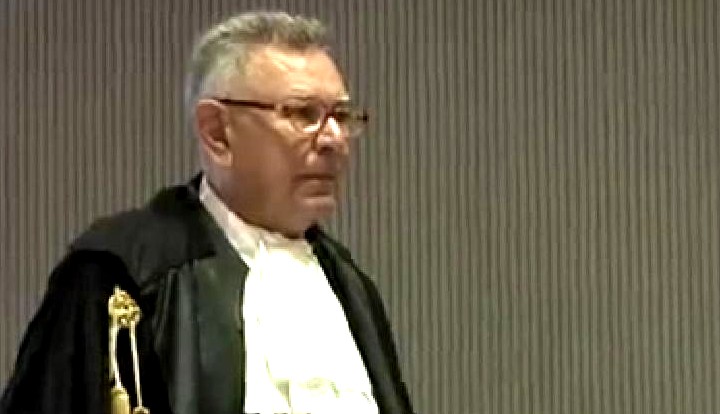
Saturday, December 14, 2013
Why Is Appeal Prosecutor Crini So Very, Very Interested In The Precise Position Of Filomena’s Door?
Posted by Cardiol MD
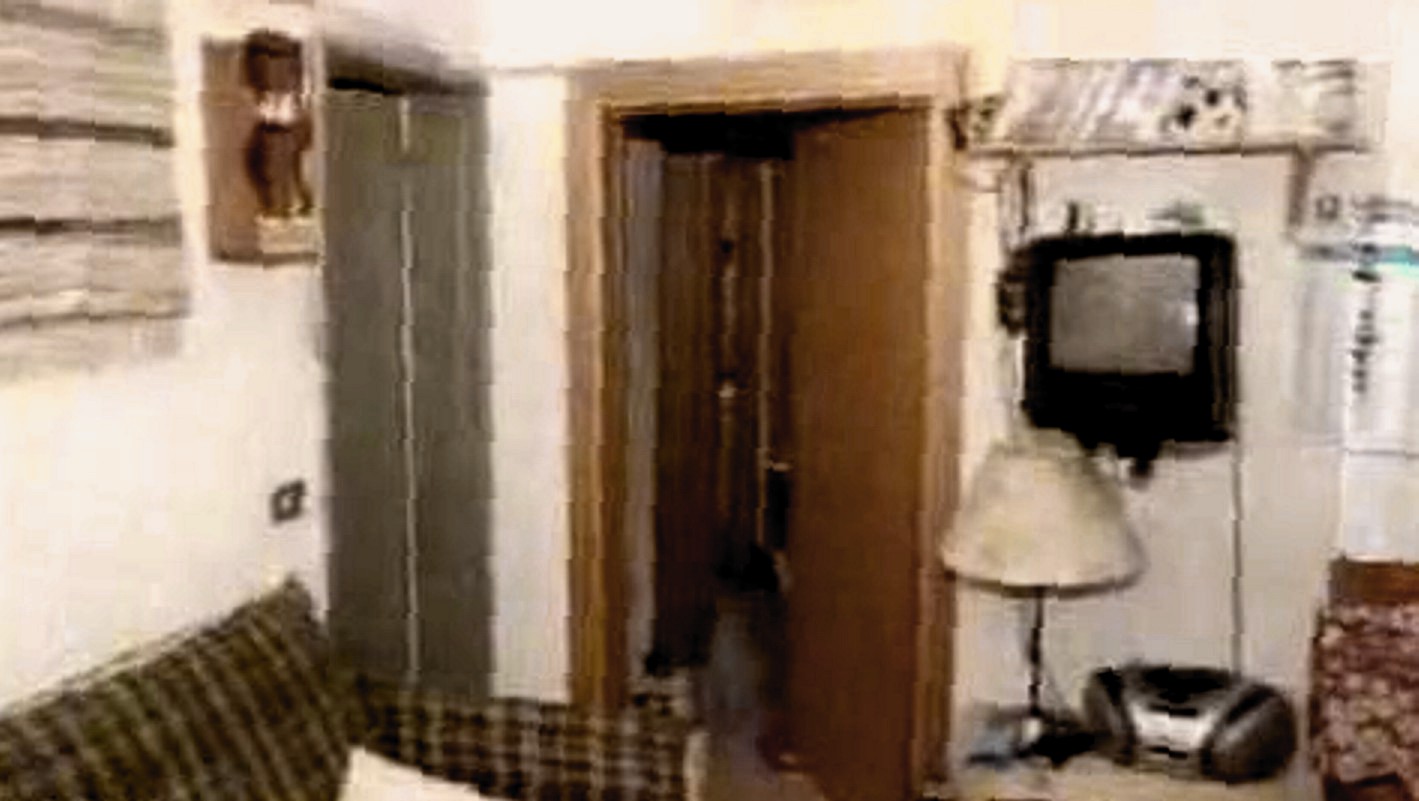
[Above, we can see Filomena’s grey door, at hard left; ahead are Meredith’s & Knox’s bedrooms]
Do please bear in mind that this appeal was initiated by Knox and Sollecito, and the verdict, sentence and sentencing report they dispute is Judge’s Massei’s from the 2009 trial.
The subject of one of Dr Crini’s focuses - whether or not Filomena’s door was open at the various times Knox and Sollecito stated they went to the women’s apartment on the morning-after ““ is a crucial one, relevant to proving Knox’s and Sollecito’s lies and obfuscations.
Wasn’t the staged break-in to Filomena Romanelli’s room glaringly obvious? In the early morning of November 2nd, 2007? In spite of the Knox/Sollecito obfuscations? There is much information in Massei on this question, pointing to many very obvious obfuscations.
Now, for the legal requirements of beyond-reasonable-doubt (BRD) actual, literal quotations are needed. Much relevant information can easily get “˜lost in translation’ not only at the superficial level of paraphrase, as in “They said that”¦..”, but also at the more subtle level of the formats used for quotations.
Some of the Massei Report as translated consists of the actual oral quotations of witness statements, some are quotations of the content of written documents, but some consist only of paraphrases of both oral statements and of written documents.
For some quotations, especially nested-quotations the translation uses various formats, beginning either with a comma or an apostrophe, ending with an apostrophe, and, in my copy, some back-slashes.
This mixture can be confusing to some readers, and Knox and Sollecito are seasoned veterans of exploiting such translational losses. That is a major factor in their continuing obstruction of justice: using chronic obfuscation.
He said, “She yelled, ‘I’m going to kill you.’ “
This quotation-format has been substituted in this post where it seems appropriate. It is hoped that when this format is used only to indicate editorial irony it will be self-evident.
John Follain and Will Savive also make a number of relevant references, and so do some Wiki articles whose authors are too modest to identify themselves though “˜Underhill’ has been mentioned as a co-ordinator.
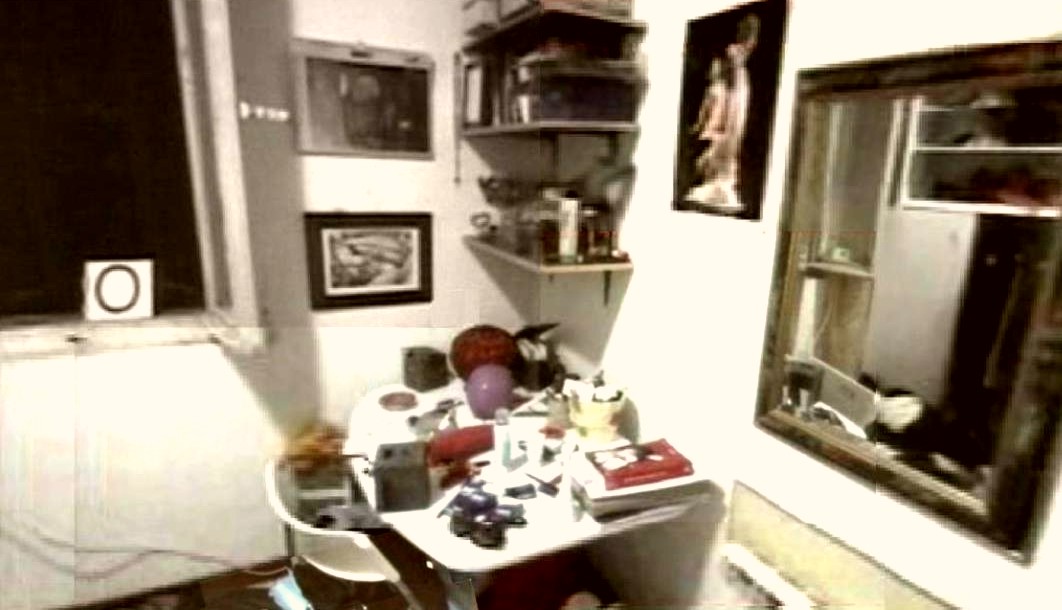
Of course, the members of the Florence Appellate Court have access-to, have probably already read, thousands of pages of evidence, including the actual verbatim witness-transcripts, and that Court will make up its own mind independent of what is written elsewhere.
Here are some of the Massei “˜door’ instances - this is a selection of a relevant 6 out of a grand total of 192 instances:
Massei Page 28: [Amanda Knox and Raffaele Sollecito ““ said that they were waiting for the carabinieri whom they had called since “coming back to the cottage in the morning because they had been away for the night” and finding “the entrance [15] door open and then the window broken” (see declarations by Battistelli, hearing of February 7, 2009, page 64).]
Access to the Court Records would help us better-understand this passage, but Follain (Page 67, Kindle location 939), indicates that Battistelli is actually quoting Sollecito, substituting “˜they’ for “˜we’, so it seems that Sollecito was already obfuscating the facts, encouraging the inference that their shocking observations began only when both he and Knox arrived together and discovered together both the open apartment entrance-door, and from inside Filomena’s room, the broken-window, so we are all being steered away, by Sollecito, from the true answer to our question.
Massei Pages 29-30: [Around midday(Nov, 2nd, 2007), at ten past twelve, when they had not yet arrived at the car park of the Fair, and she(Filomena) was in the car with her friend Paola Grande, she received a phone call: it was Amanda letting her know that there was something strange. She had arrived and had found the door open: she had had a shower and it had seemed to her that there was some blood; moreover she said that she was going [17] to Raffaele’s place (declarations of Romanelli page 31, hearing of February 7, 2009).
To her (Filomena’s) question about where Meredith was, she had answered that she did not know.]
Filomena had apparently not been told by Knox, in this 1st phone-call, about the broken pane, the stone, and the bedroom-disarray, as if Knox was not yet aware of these stunning facts. The obfuscation continues.
Massei Page 30: [Marco Zaroli, who was without a car because Ms. Romanelli had taken it, had called his friend Luca Altieri and they had gone together to the house in Via della Pergola, where they arrived around 1:00 pm, at almost the same time as Filomena Romanelli and Paola Grande. In the house there were the also the two present accused and ““ as we have seen ““ Inspector Battistelli and Assistant Marzi. The presence of the latter two was linked by Ms. Romanelli to what Amanda had told her about the open door, the broken pane, her own room in a mess.]
When Knox first told Ms. Romanelli about her visit, she had omitted reference to Laura’s and Filomena’s doors, whether they were open, whether they were openable, whether Knox opened them, and whether Knox looked inside and saw the broken pane, the stone, and the bedroom-disarray. It is implausible that Knox tried only Meredith’s door and not the others.
It is also implausible that Knox even took a shower at the women’s apartment, colder as it was than Sollecito’s. Amy Frost testified that hours after the body was discovered Amanda Knox told her that she never took the shower, because when she noticed the blood that had stopped her from showering.
The Postal Police commented that Knox also emanated an unpleasant, “˜post-shower’ odour, inconsistent with Amanda having recently had a shower anywhere, implying Knox was lying about taking the shower.
Knox is steering Ms. Romanelli away from these crucial facts which logically demanded that their “˜discoverer’ flee (again), and call the Police. Knox is obfuscating by selective piece-meal feeding-of-the-facts to Filomena.
Massei Page 38: [On the day of November 2, 2007 at police headquarters, Amanda was also there and she said that that night she had been with her boyfriend Raffaele and that the next morning at around 11:00 am she had gone back home to get changed. She had found the entrance door open and this seemed strange to her: she had gone into the house and into her room and she had taken a shower and had seen drops of blood.
She said that after the shower she got dressed and noticed that Meredith’s door was locked. She went into the other bathroom and said that there were faeces in the toilet. Then she went into another room and noticed that the window had been broken and that there was glass inside. She told these things to her and the other girls present. Then she related that she had gone back to Raffaele’s house and had rung Filomena. She remembered that on that occasion at police headquarters Raffaele was very calm, silent.]
When Knox first called Filomena, Knox had omitted any mention of the most significant information - the (staged) break-in, as if she had not ‘noticed’ it.
Now, later, paraphrasing, Massei states: “Then she went into another room and noticed that the window had been broken and that there was glass inside.”
Had Massei not paraphrased, but had written “Then I went into Filomena’s room and ‘noticed’ that her window had been broken and that there was glass inside.”, we could use it as BRD evidence.
The actual, verbatim quote should be among the many thousands of Court Records relied upon by Massei; Nencini’s Court should use such Record in reaching its decision.
Massei Page 65: [Upon returning home, she [Amanda] noticed that the door was wide open. She thought someone had gone to take the trash out or gone to the floor below, closing the door behind them but not locking it. She asked loudly whether anyone was at home, but no one answered. The door to Meredith’s room was closed, and this meant she was sleeping. She undressed in her own room and took a shower in the bathroom, (the one) nearest to (both) her room and to Meredith’s.
When she got out of the shower, she realised that on the little bath mat where she had placed her feet, there was blood and also, there were drops of blood on the sink and the faucet. She left the bathroom and went to get dressed in her own room. Then, she went in the other bathroom to dry her hair, where there was a blow dryer. It was at this time that she noticed feces in the toilet, which surprised her. She then took the mop and returned to Raffaele’s home, locking the door (on the way out.)
She told Raffaele what she had seen and he suggested that she call one of her friends. She then called Filomena Romanelli, who said that she had been out with her boyfriend and that Laura Mezzetti was also away, in Rome with her family. She then realised that the only one to have spent the night in Via della Pergola was Meredith, about whom, however, nothing was known. Filomena seemed worried, so Amanda (Page 66) told her that she would call Meredith, who would then call her back.
She then called the two cellphones that Meredith had, but without getting any response (from her). She then returned home, this time with [55] Raffaele. Upon returning home, she opened the door to Filomena Romanelli’s room and saw that the window was open and completely broken: there was chaos, “šbut her computer was in its place on the desk.”› Convinced that there had been a burglary, she went into the other rooms: Laura’s room was in order, and nothing was missing from her own room.
However, Meredith’s door was closed. She began to knock and to call out, without receiving any answer. She was then seized with panic and went on the balcony to see if she was able to see anything, but she couldn’t see anything. She went down to the apartment below to ask someone, but no one was there. She therefore went back inside and Raffaele said that he wanted to try to break down the door of Meredith’s room, but he wasn’t able to. It was then that they decided to call the police, which is what Raffaele did. She let Filomena know about this, asking her to come home.]
Now, only after returning “home, this time with [55] Raffaele.” does Knox allege that she had then “opened the door to Filomena Romanelli’s room and saw that the window was open and completely broken: there was chaos, “šbut her computer was in its place on the desk.”
Knox continues to obfuscate by selective piece-meal feeding-of-the-facts.
Massei Page 66: [While they were waiting, two police officers arrived (at the scene) and she showed them all that she had seen. Then Filomena arrived with her boyfriend and two other friends, and they broke down the door of Meredith’s room.]
True. There are a number of other Massei references to Filomena’s door and room, but they are basically repetitive of information already in the above references.
This seems to be enough for Nencini’s Court to reach its verdicts re Knox and Sollecito.
[Below: the area from which Knox would have been looking at Filomena’s door]
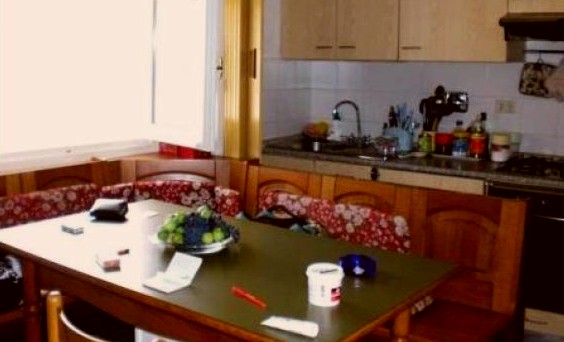
Monday, December 02, 2013
A Second Analysis Of Amanda Knox’s Email To Family And Friends Of 4 November 2007 DRAFT
Posted by Peter Quennell
I have been trawling through Knox’s infamous email that she wrote to her “friends” in the US shortly after she had cruelly murdered poor Meredith. Here are my thoughts - apologies to all if I am covering old ground.
I have interspersed Knox’s email record, (as she had written it), with my own comments. Hope they are useful to TJMK’s fight for justice for Meredith.
Email by Amanda Knox
This is an email for everyone, because I’d like to get it all out and not have to repeat myself a hundred times like I’ve been having to do at the police station. Some of you already know some things, some of you know nothing.
This reads as if Knox is establishing an alibi and a chronology from the outset. The structure is an odd mix of quasi-formality and off the cuff anecdote.
She does not feel the need to explain why she has had to repeat herself a hundred times at the police station. After all, an innocent person would tell the truth once, with perhaps minor corrections. Only a person, like Knox, who was changing her story to the police so often, would need to repeat herself endlessly. By default, therefore, she is admitting that her story is proving unbelievable, so this email is her attempt to garner psychological support and credence from her family and friends in the US.
What I’m about to say, I can’t say to journalists or newspapers and I require that of anyone receiving this information as well.
Here and repeated further on in this email, Knox is blatantly breaching the strict advice that she remains publicly silent, particularly in relation to the media. She has no control over this email “information”, once she has sent it to her multiple recipients, because she cannot be sure that it will not leak to third parties.
This is my account of how I found my roommate, murdered, the morning of Friday, November 2nd.
Strictly formal in style, much as one would expect of a written statement to the police. Knox seeks to assuage her psychological turmoil and gain mental control because she knows she has repeatedly lied to the police and none has yet, (understandably), believed her.
The last time I saw Meredith, 22, English, beautiful, funny, was when I came home from spending the night at a friend’s house.
The insertion of “22, English, beautiful, funny” seems completely inappropriate in relation to a recently, brutally murdered Meredith. It reads as if a third-rate novelist is introducing a key character. Thus Knox reveals her email to be a self-serving, imaginary construct ““ not factual and honest, as an innocent person would write.
It was the day after Halloween, Thursday. I got home and she was still asleep, but after I had taken a shower and was fumbling around the kitchen, she emerged from her room with the blood of her costume (vampire) still dripping down her chin.
Showers, in this email, seem to be a major obsession for Knox. Could she be trying to wash away her oppressive psychological feelings of guilt?
We talked for a while in the kitchen, how the night went, what our plans were for the day, nothing out of the ordinary”¦..,
Why should Knox note, “Nothing out of the ordinary” in this routine conversation, other than she is trying to paint a benign landscape of her relationship with Meredith? (In fact, we know from independent witnesses that Meredith had become increasingly annoyed by Knox’s anti-social behaviour around the house)
“¦and I began to start eating a little, while i waited for my friend (Raffaele-at whose house i stayed over) to arrive at my house. He came right after I started eating and he made himself some pasta.
Note Knox’s truly strange attention to detail, “I began to start eating a little” and “He came right after I started eating”. Why the almost millisecond importance of eating? I believe that Knox is highlighting the timing of Sollecito’s arrival to establish that they were therefore together when Meredith was alive and that they remained so until her body would be discovered. This seeks to build an apparently highly accurate and continuous chronology for their alibi.
As we were eating together, Meredith came out of the shower and grabbed some laundry or put some laundry in, one or the other, and returned into her room after saying hi to Raffael
Knox mentions the word “grab” repeatedly throughout this email. It does not signify a factual rush to do something, but her psychological need to create a fleeting impression about recollections that she knows to be untrue.
It is also odd that Knox feels the need to highlight the “laundry”, but is immediately vague on whether or not it was before or after the wash. This is the sort of detail that adds nothing of factual relevance, but tends to create the impression that Knox is making it up as she goes along. Repeatedly, throughout all her statements, she fluctuates between sudden accuracy about certain unimportant facts or those that support her claimed innocence, but becomes, equally suddenly, very “confused” when it relates to important facts that might establish her guilt.
After lunch, I began to play guitar with Raffael and Meredith came out of her room and went to the door. She said bye and left for the day. It was the last time I saw her alive.
This is a very laborious and therefore insincere recall. Most innocent people would simply recall that, “After lunch, Meredith said goodbye and left for the day”. Knox’s attention to detail appears necessary only because she is carefully constructing a knowingly dishonest version of events and placing herself in it, as if she were an innocent spectator.
After a little while of playing guitar, I and Raffael went to his house to watch movies and after, to eat dinner and generally spend the evening and night indoors. We didnt go out.
Once again, Knox takes great care to build a continuous, but dishonest, alibi. She seeks to reassure herself by creating a fantasy narrative, with Sollecito and her as the key actors.
How can one “generally spend the evening and night indoors”? Either they did or they didn’t do so. Period.
Why, if they did stay in, does Knox feel the need to expressly state, “We didn’t go out”?
It would appear that Knox is grappling with her inner knowledge that she is telling whopping great lies, but by repeating them, she can establish the alibi in her mind and also reassure herself, (and the FOA), that she is telling the truth.
The next morning, I woke up around 1030 and after grabbing my few things, I left Raffael’s apartment and walked the five-minute walk back to my house to, once again, take a shower and grab a change of clothes.
As above, we have two instances of “grabbing”, indicating a specific desire to skip quickly across her conscious lies. Knox again stresses a shower, a subconscious effort to cleanse her burdensome knowledge of guilt.
I also needed to grab a mop because, after dinner, Raffael had spilled a lot of water on the floor of his kitchen by accident and didnt have a mop to clean it up.
This is not the first time that Knox alludes to this water issue and therefore, the need to collect the mop from her house. Unfortunately, Sollecito’s and her versions vary between a “spillage” and a “leak” from the sink.
These descriptions mean two different things. A “spillage” indicates a human cause, whereas a leak indicates a failure in the pipes.
Judge Massei has rightly questioned the need to collect a mop from Knox’s house, when Sollecito had a janitor service at his house.
I don’t think anyone on TJFM has suggested a perhaps more likely reason for Knox “grabbing” her mop and taking it to Sollecito’s house, one that has nothing to do with leaks or spillages at the latter house.
We know that there was a concerted clean-up of the murder scene, most likely after Knox had purchased cleaning agents/bleach from the shop, early on the morning of November 2nd 2007. It would make sense that Knox and Sollecito, bare foot, used Knox’s house mop to wash down the floors. It would be potentially very risky to leave that mop at the murder scene thereafter, (no matter how well it was rinsed), for fear that traces of Knox’s and/or Solliceto’s incriminating DNA remained for detection by forensics, mixed with Meredith’s DNA.
It was simply much safer to take the mop away, as they left the house.
It would be interesting to know if the police ever found Knox’s original mop and whether it would have yielded any incriminating DNA evidence.
So, I arrived home and the first abnormal thing I noticed was the door was wide open.
Note: Knox immediately notes that the “wide open” door was “abnormal”.
Here’s the thing about the door to our house:
It’s broken, in such a way that you have to use the keys to keep it closed.
if we dont have the door locked, it is really easy for the wind to
blow the door open and so my roommates and I always have the door
locked unless we are running really quickly to bring the garbage out
or to get something from the neighbors, who live below us.
Who “runs really quickly” to bring garbage out? Only someone like Knox, who is trying to persuade herself and the FOA that it would justify leaving an entrance door “wide open”. Most sensible tenants would have demanded that the landlord repair the door and secure the property, particularly as it housed four young women.
(Another important piece of information: for those who dont know, I inhabit a
house of two stories, of which my three roommates and I share the
second story appartment. there are four Italian guys of our age
between 22 and 26 who live below us. We are all quite good friends and we talk often. Giacomo is especially welcome because he plays guitar with me and Laura, one of my roommates and is, or was, dating Meredith. The other three are Marco, Stefano, and Ricardo.)
Why is this information so “important”, particularly for “those who don’t know”? The only reason seems to be an opportunity for Knox to create the illusion that she was very sociable. We know, according to independent witnesses, that Knox had distinct character quirks that made social contact uncomfortable for all who met her, (bar Solliceto).
Anyway, so the door was wide open. Strange, yes, but not so strange that I really
thought anything about it.
Note: now Knox cannot make up her mind whether the “wide-open” door is “odd/strange” or “not so strange that I really thought anything about it”. The truth is that these expressed reactions are mutually exclusive. Indeed, she goes on immediately to show that she DID think something about it”¦.
I assumed someone in the house was doing exactly what I just said, taking out the trash or talking really quickly to the neighbors downstairs. So I closed the door behind me
but I didnt lock it, assuming that the person who left the door open would like to come back in.
A lot of “thinking” here, all of it a self-serving excuse as to why Knox didn’t call the police straight away.
When I entered, I called out if anyone was there, but no one responded and I assumed that if anyone was there, they were still asleep.
This was another of Knox’s BIG assumptions, taking no care to even consider that there might have been a genuine break-in or that the culprit might be still lurking in the house.
Laura’s door was open which meant she wasn’t home, and Filomena’s door was also closed. My door was open like always and Meredith door was closed, which to me meant she was sleeping.
Knox seems to be so knowledgeable about her housemates’ whereabouts, simply by the status of their respective bedroom doors!
In fact, Knox knew that both Filomena and Laura would be away for the long weekend and that only Meredith would be in the house on 01/11/2007.
I undressed in my room and took a quick shower in one of the two
bathrooms in my house, the one that is right next to Meredith and my
bedrooms, (situated right next to one another).
It was after I stepped out of the shower and onto the mat that I noticed the blood in the
bathroom. It was on the mat I was using to dry my feet and there were
drops of blood in the sink.
At first, I thought the blood might have come from my ears, which I had pierced extensively not too long ago, but then, immediately, I know it wasn’t mine because the stains on the mat
were too big for just droplets from my ear, and when I touched the
blood in the sink it was caked on already.
Who pierces their ears “extensively”? Knox, here, is desperate to try to link bleeding from alleged tiny earlobe punctures with the volume of blood visible in the sink and on the mat.
There was also blood smeared on the faucet. Again, however, I thought it was strange
because my roommates and I are very clean and we wouldn’t leave blood
in the bathroom, but I assumed that perhaps Meredith was having
menstral issues and hadn’t cleaned up yet. Ew, but nothing to worry
about.
Again, lots of “strange” blood that Knox immediately seeks to explain away by careless and indeed ridiculous “menstral” bleeding.
More importantly, note here that Knox only considers that she and/or Meredith could be the only source of the blood. She had arrived back to a “wide-open” door, which could have allowed any bleeding person to enter the bathroom unimpeded.
In fact, Knox is grappling again with her knowledge that the blood is a mixture of Meredith’s and her own DNA. By suggesting her bleeding ear piercings and Meredith’s “menstral issues”, Knox is making a feeble attempt to put together an innocent, advance explanation for any mixture of Meredith’s and her blood that subsequent forensic examination might identify.
Still, Knox shows not the slightest concern that her house is “wide-open” and there is blood in the bathroom. An innocent person would have immediately contacted her housemates, accounted for their safety and then called the police.
I left the bathroom and got dressed in my room. After I got
dressed, I went to the other bathroom in my house, the one that
Filomena and Laura use, and used their hairdryer to obviously dry my
hair”¦
Why does Knox state “”¦.obviously to dry my hair”? Why otherwise would anyone normally use a hair dryer?
“¦ and it was after I was putting back the dryer that I noticed the
shit that was left in the toilet, something that definitely no one in
our house would do.
NOTE: Knox confirms here that she first noticed the “shit” in Filomena and Laura’s toilet and that it could not be that of any of the housemates.
I started feeling a little uncomfortable.
Only a “little”? How many indications did Knox need to conclude that something was seriously amiss? Still, she made no call to the police or her housemates.
Note again that she only “started” to feel uncomfortable ““ no more than that. She constantly seeks to express her alleged concern on one hand and simultaneously write it off on the other.
and so I grabbed the mop from out closet and left the house, closing and locking the door that no one had come back through while I was in the shower, and I returned to Raffael’s place.
This is another “grabbing” remark to skip over another deliberate untruth. It also seems to imply that her discomfort made her leave the house in a hurry, (see below).
How does Knox know whether or not anyone had come in through the open door, while she was in the shower?
After we had used the mop to clean up the kitchen, I told Raffael about what I had seen in the house over breakfast. The strange blood in the bathroom, the door wide open, the
shit left in the toilet. He suggested I call one of my roommates, so I
called Filomena.
So here we have Knox, having left her house feeling “uncomfortable” for all the reasons that she stated in this paragraph, but then goes to Sollecito’s house where she and Sollecito allegedly “cleaned up the kitchen”, (note: not “”¦.mopped up the water spillage/leak”).
They then make breakfast and it is only “over breakfast” that Knox gets round to sharing this troubling and uncomfortable information with Sollecito.
An honest person would have told Sollecito straight away, upon her return. Why was Knox so nonchalant about the “strange” things at her house? Perhaps because she and Sollecito, (as the murderers), already knew all about them and that she is now constructing this fantasy alibi to cover their guilty asses.
Filomena had been at a party the night before with her boyfriend, Marco, (not the same Marco who lives downstairs but we’ll call him Marco-f as in Filomena and the other can be Marco-n as in neighbor).
She also told me that Laura wasn’t at home and hadn’t been
because she was on business in Rome. which meant the only one who had
spent the night at our house last night was Meredith, and she was as
of yet unaccounted for.
Knox therefore confirms that she already knew that both Filomena and Laura were out of town for the long weekend. Filomena testified that she had asked Amanda, on the afternoon of 01/11/2007, to help her wrap a birthday present for the party.
Filomena seemed really worried, so I told her I’d call Meredith and then call her back.
Knox seems quite surprised at the extent of Filomena’s worried response. The real surprise is that Knox is the only one, of all the housemates and Meredith’s friends, who behaved in a totally inappropriate and cold manner, both leading up to the discovery of Meredith’s body and particularly afterwards at the police station.
The phone record shows that Knox is telling more lies here ““ she had already rung Meredith’s phones before ringing Filomena.
Judge Massei found that Knox had done so, not out of any concern about Meredith, (the calls only lasted 3 or 4 seconds), but to establish that the discarded phones had not yet been found. Having satisfied herself that the phones remained undiscovered and that no investigation could yet be underway, the coast was clear for Knox to ring Filomena and thereby set the wheels in motion of the inevitable discovery of Meredith’s body.
I called both of Meredith’s phones, the English one first and last and the Italian one between.
No, this was BEFORE Knox first called Filomena, (see above). The phone record completely destroys Knox’s alleged call chronology and proves her, without doubt, to be a liar.
The first time i called the English phone, it rang and then sounded as if
there was disturbance, but no one answered.
What kind of “disturbance”? Was Knox trying to imply that someone else had the phone at that stage?
I then called the Italian phone and it just kept ringing, no answer.
I called her English phone again and this time an English voice told me her phone was out of
service.
Oh well, Knox, never mind”¦.
Raffael and I gathered our things and went back to my house.
I unlocked the door and I’m going to tell this really slowly to get
everything right, so just have patience with me.
Revealingly, Knox had to warn herself to be careful here ““ she wouldn’t want a slip up in her alibi, would she? No innocent person would ever have the need to write such a phrase.
The living room/kitchen was fine. Looked perfectly normal. I was checking for
signs of our things missing, should there have been a burglar in our
house the night before.
Why did she not do this when she had first gone to her house earlier that morning?
Filomena’s room was closed, but when I opened the door, her room was a mess and her window was open and completely broken, but her computer was still sitting on her desk like, it always was and this confused me.
Yes, Knox, of course it did, but you bravely persevered with your search”¦
Convinced that we had been robbed, I went to Laura’s room and looked quickly in, but it was spotless, like it hadn’t even been touched. This, too, I thought was odd.
This alleged robbery becomes even more strange for Knox ““ “convincing” but at the same time, “odd”. The only explanation, (which she knew and was discovering more and more flaws in it), was that it was a “staged” break-in of Sollecito’s and her own making.
I then went into the part of the house that Meredith and I share and checked my room
for things missing, which there weren’t.
Phew, that must have been a relief! Most (innocent) people would have checked their own room first.
Then I knocked on Meredith’s room, but when she didnt respond. I knocked louder and louder until I was really banging on her door and shouting her name. No response.
Either Meredith wasn’t in, (the most likely reason) but she had not answered her phones.
Why did Knox not call the police immediately?
Panicking, I ran out onto our terrace to see if maybe I could see over the ledge into her
room from the window, but I couldn’t see in. Bad angle.
The “angle” was the same as it had always been. It was only a small house. Why did Knox allegedly try to see through Meredith’s window when it was out of the line of sight from the terrace?
I then went into the bathroom where I had dried my hair and looked really quickly
into the toilet. In my panic, I thought I hadn’t seen anything there,
which to me meant whoever was in my house had been there when I had
been there.
As it turns out, the police told me later that the toilet was full and that the shit had just fallen to the bottom of the toilet, so I didnt see it.
Why, in a state of panic, did Knox suddenly decide to inspect the toilet bowl in Filomena’s bathroom? Knox has already written, (see above, in this discussion), that she had noticed the unusual “shit” in the toilet during her first visit to the house earlier that morning.
Why would the police discuss with Knox the position of the “shit” as a means of helping her to understand why she had completely failed to notice it in her “panic”?
Knox deduces that whoever had left the shit in the bowl had been there when she was there. It turned out to be Guede’s shit, therefore Knox is admitting that she was with Guede on the night of Meredith’s murder and Guede has been convicted of the crime - one for which he is co-responsible with Knox and Sollecito.
I ran outside and down to our neighbors’ door. The lights were out, but I banged on the door anyway. I wanted to ask them if they had heard anything the night before, but no one was
home. I ran back into the house.
Knox knew that the boys downstairs were going away for the long weekend before she murdered Meredith. Why would Knox have pounded of the door of a house that she had known was empty?
In the living room, Raffael told me he wanted to see if he could break down Meredith’s door. He tried, and cracked the door, but we couldn’t open it. It was then that we decided
to call the cops.
What a wimp! The housemates’ boyfriends, when they discovered that Meredith was missing and that her door (unusually) locked, had no trouble breaking down the door and unlike Sollecito, they were not trained in kick-boxing.
Finally, they called the cops!! Knox did so with no urgency whatsoever. She and Sollecito delayed calling the police for as long as possible, to give themselves time to construct an agreed alibi and to check that everything was in place, at the murder scene, to indicate a “lone wolf” break in and attack on Meredith.
There are two types of cops in Italy, Carabinieri, (local, dealing with traffic and domestic calls) and the police investigators.
He first called his sister for advice and then called the Carbanieri.
I then called Filomena, who said she would be on her way home immediately.
Knox is a liar here again. These remarks are unsupported by the phone record.
While we were waiting, two ununiformed police investigators came to our house. I showed them what I could and told them what I knew. Gave them phone numbers and explained a bit in broken Italian, and then Filomena arrived with her boyfriend, Marco-f
and two other friends of hers.
These uniformed police confirmed that both Knox and Sollecito looked very surprised to see them. Neither of them knew that the phones had been discovered, (ironically one had been discovered when Knox had rung it a little earlier), and that these police had arrived to investigate their loss and return them to Filomena and Meredith.
No word from Knox as to why she and Sollecito were surprised to see these police.
All together, we checked the house out, talked to the police and in a bit, they all opened Meredith’s door.
I was in the kitchen, standing aside, having really done my part for
the situation. But when they opened Meredith’s’ door and I heard
Filomena scream, “a foot! a foot!”, in Italian, I immediately tried to
get to Meredith’s room, but Raffael grabbed me and took me out of the
house.
This is a complete fabrication. Knox speaks as someone who knew that the opened bedroom door would reveal Meredith’s body. No innocent person would stand back, aloof and disinterested, when all the others were anxious to break down the door.
Which innocent person would lapse into complete disinterest because “I had already done my part for the situation”. Sounds as if Knox felt she had acted that part of the planned alibi script and was waiting to resume the act at a later stage.
Knox then tries to establish that she tried to get to Meredith’s room because Filomena had screamed “a foot”. Again, Sollecito saved the day by “grabbing”, (that word again!), her and taking her outside because Filomena had screamed out “a foot”.
It is a fact that both Knox and Sollecito obviously knew details of the murder scene, but had not been present to see into the bedroom when the door had been broken down.
Thus, Knox is trying here to establish how she knew about the disposition of Meredith’s body, without needing a line of sight on the murder scene.
The police told everyone to get out and not long afterward the
Carabinieri arrived and then soon afterward, more police
investigators. They took all of our information and asked us the same
questions over and over.
The police had not asked the same questions “over and over” of any other, (innocent), witnesses, just of Knox and Solliceto. Why? I suspect that only Knox and Sollecito needed repeated questions because only they were telling inconsistent and changing stories.
Knox simply does not understand that the police only tend to ask the same questions “over and over” if the witness is being dishonest and evasive by giving inconsistent and contradictory answers. She may as well admit that her answers were and are just that.
At the time, I had only what I was wearing and my bag, which thankfully had my passport in it and my wallet. No jacket though, and I was freezing.
Was Knox trying to cover up her nervous trembles, during her answers to difficult questions, by trying to claim here that she was “freezing”?
After sticking around at the house for a bit, the police told us to go to the station to give testimony, which I did.
I was in a room for six hours straight after that, without
seeing anyone else, answering questions in Italian for the first hour
and then they brought in an interpreter and he helped me out with the
details that I didnt know the words for..
An innocent person would never submit to an interview in a murder case, without fluency in the local language
Knox repeats here the allegations of extended questioning and sleep/food/water deprivation to try to excuse her admissions in her signed, written statements. The facts show that she had only about three hours of questioning, the remainder of the time at the police station being spent on giving long, voluntary accounts of her part in the events, at her request.
No person EVER admits to a callous murder, except perhaps under overt torture. Knox has never claimed torture during questioning.
They asked me, of course, about the morning, the last time I saw her, and because I was the closest to her, questions about her habits and her relationships.
Here, Knox is attempting to create an untruthful impression of a close and warm relationship with Meredith. Meredith’s friends consistently claim to the contrary.
Afterwards, when they were taking my fingerprints, I met two of
Meredith’s English friends, two girls she goes out with, including the
last one who saw her alive that night she was murdered. They also had
their prints taken.
After that, (this was around 9 at night by this time), I was taken into the waiting room where there was various other people who I all knew from various places, who all knew Meredith. Her friends from England, my roommates, even the owner of the pub she most
frequented.
After a while, my neighbors were taken in too, having just arrived home from a weeklong vacation in their home town, which explained why they weren’t home when I banged on their door.
Of course it did, Knox. You knew that the neighbours had gone away for the weekend. In fact, as you knew that only Meredith would be in the house, it was a perfect opportunity to assault and murder her.
Later than that, another guy showed up and was taken in for questioning, a guy I
dont like, but whom both Meredith and I knew from different occasions, a
Moroccan guy that I only know by his nickname amongst the girls,
“shaky”.
Big, bad BLACK guy, that is, not an all-American, sweet, apple pie gal like good ole Amanda…
Then I sat around in this waiting room, without having the
chance to leave or eat anything besides vending machine food, (which
gave me a hell of a stomach ache) until 5:30 in the morning.
Knox made no official complaint about this alleged mistreatment by the police. On the contrary, she confirmed, in court, that the police had treated her well, including supplying food and drinks to her. More lies.
During this time, I received calls from a lot of different people, family
mostly of course, and I also talked with the rest, especially to find
out what exactly was in Meredith’s room when they opened it. Apparently
her body was lying under a sheet, and with her foot sticking out and
there was a lot of blood. Whoever had done this had slit her throat.
Here, Knox records another explanation of how she knew about the crime scene details, while never having been in the position to see them. These are lies, again, of course.
They told me to be back in at 11am. I went home to Raffael’s place,
ate something substantial and passed out.
Altogether, what with the murder, staged break in, intensive overnight cleanup of the murder scene, giving consistently contradictory evidence to the police and maintaining an aura of sweet innocence, I am not surprised that Know alleges that she “passed out”. She must have been knackered. Photos of the pair on the morning after the murder show both to be drawn and unkempt.
In the morning, Raffael drove me back to the police station, but had to
leave me when they said they wanted to take me back to the house for
questioning.
Before I go on, I’d like to say that I was strictly told not to speak about this, but I’m speaking with you people who are not involved and who can’t do anything bad except talk to journalists, which I hope you won’t do. I have to get this off my chest because it’s
pressing down on me and it helps to know that someone besides me knows
something and that I’m not the one who knows the most out of everyone.
Why does Knox reveal information here, about which she had been “strictly told” not to speak? This shows her unwillingness to accept any boundaries in her behaviour.
What is pressing on Knox’s chest? The guilt of having murdered Meredith or more likely, that she cannot persuade anyone, (outside the FOA), to believe her changing stories and denials of fact.
Knox inadvertently concedes here that she “”¦ knows the most out of everyone”. I would suggest that the only way to know that much is to be the murderess.
Pathetically, she is seeking to share her guilt by passing the buck of responsibility onto others, who by swallowing her stories, hook, line and sinker, can become witting or unwitting co-conspirators in her deception.
At the house, they asked me very personal questions about Meredith’s
life and also about the personalities of our neighbors. How well did I
know them? Pretty well, we are friends. Was Meredith sexually active?
Yeah, she borrowed a few of my condoms. Does she like anal? WTF? I
dont know. Does she use Vaseline for her lips? What kind of person is
Stefano? Nice guy, has a really pretty girlfriend.
I have no doubt that Knox could fill in any gaps in her knowledge here by telling her usual lies, as she always has done and continues to do.
Hmmm”¦very interesting. We’d like to show you something, and tell us if this is
out of normal.
Why would the police rely on Knox for an honest answer to ANY question?
They took me into the neighbors’ house. They had broken the door open
to get in, but they told me to ignore that.
Why would the police have broken the door down, rather than simply call the young men home and keep their part of the house sealed off until they had arrived?
The rooms were all open. Giacomo’s and Marco-n’s rooms were spotless, which made sense because the guys had thoroughly cleaned the whole house before they left on
vacation.
This is Knox reaching quick conclusions on matters about which she has no knowledge. How ironic that she cannot reach any consistent and revealing conclusion about Meredith’s murder, about which she knows so much
!
Stefano’s room however, well, his bed was stripped of linens,
which was odd, and the comforter he used was shoved up at the top of
his bed, with blood on it. I obviously told then that the blood was
definitely out of normal and also that he usually has his bed made.
They took note of it and ushered me out.
How can Knox be such an expert about Stephano’s room, his blood and his personal habits? More lies and fantasy.
When I left the house to go back to the police station, they told me to put my jacket over my head and duck down below the window, so the reporters wouldn’t try to talk to
me.
At the station, I just had to repeat the answers that I had given
at the house, so they could type them up and after a good 5 and a half
hour day with the police again, Raffael picked me up and took me out
for some well-deserved pizza. I was starving.
Again, Knox admits that she has to answer the same, repeated questions, oblivious to the fact that this must imply that her answers are inconsistent and God Forbid, dishonest.
I then bought some underwear because, as it turns out, I won’t be able to leave Italy for a
while, as well as enter my house. I only had the clothes I was wearing the day it began, so i bought some underwear and borrowed a pair of pants from Raffael.
So Knox only buys underwear because she cannot leave Italy or enter the house? Does she not need any other clothes?
Spoke with my remaining roommates that night (last night) and it was a hurricane of emotions and stress, but we needed it anyway.
I would suspect Knox, more than anybody, to be at the centre of the “hurricane”. Innocent people would be upset for Meredith’s loss, but would not experience anything like Knox’s stress, as a murderess trying to concoct a consistent alibi, without success.
What we have been discussing is basically what to do next. We are trying to keep
our heads on straight.
Knox, here, is admitting that she was exercised in keeping her concentration on the next phase of maintaining her concoction of lies.
First things first though, my roommates both work for lawyers, and they are going to try to send a request through on Monday to retrieve important documents of ours that are still in
the house.
These “documents” were obviously much more important than Meredith’s murder. Knox is such a narcissist ““ everything is all about her.
Secondly, we are going to talk to the agency that we used to find our house and obviously request to move out. It kind of sucks that we have to pay the next month’s rent, but the owner has protection within the contract.
Such a shame! Obviously Knox did not foresee that murdering Meredith might cost her a month’s extra rent.
After that, I guess I’ll go back to class on Monday, although I’m not sure what I’m going to do about people asking me questions, because I really dont want to talk again about what
happened. I’ve been talking an awful lot lately and I’m pretty tired of
it. After that, it’s like I’m trying to remember what I was doing before
all this happened. I still need to figure out who I need to talk to and what I need to do to continue studying in Perugia, because it’s what I want to do.
Yes, Knox, don’t let your murder of Meredith interrupt your study and future plans.
Anyway, that’s the update, feeling okay,
Better now for off-loading all this rubbish? Here’s a bit of advice, Knox, if you truly wish to offload your burden, tell the truth of your involvement in Meredith’s cruel murder.
Hope you all are well,
Amanda.
Yeah - right!
Sunday, November 10, 2013
The Crime-Scene Clean-Up: How Rudy Guede’s Diary Provides Even More Proof That It Happened
Posted by pat az

This post is crossposted from my own place. Here is one of my previous crime scene analyses on TJMK.
Rudy Guede was ultimately declared convicted by the Supreme Court in 2010 of participating in the 2007 murder of Meredith Kercher.
The prosecution claims the two other participants are Amanda Knox and Raffaele Sollecito. Knox and Sollecito are currently appealing their conviction of the same crime.
The case against the three of them involves a suspected clean up of the hallway in the apartment after the crime. Meredith’s blood was found in the bathroom, and half a footprint in her blood was found on the bathroom mat. However, there was no visible blood between Meredith’s bedroom and the bathroom.
The only visible blood in the hallway were faint partial shoe prints that led directly out the front door of the apartment.
After the murder was discovered, the media reported almost daily on developments in the case. The day of the murder, the press reported on the blood found in the bathroom and the bedroom.
But until police used luminol at the apartment on December 18th, the media didn’t report on any significant blood found in the hallway. Between November 2nd and December 18th, only one person stated that significant amounts of blood had been in the hallway.
Rudy Guede.
Rudy Guede actually wrote about it in his diary between Nov 20th and Dec 6th, after being captured in Germany.

The police arrived at the apartment on November 2nd. According to media reports, the blood they spotted immediately was only in the bathroom and Meredith’s bedroom. When the scene was more closely examined, after the discovery of the body, police found visible blood patterns on the floor left by Guede’s left shoe as he left the apartment.
None of the people who arrived in the apartment on the afternoon of November 2nd reported seeing them; these footprints are not in any of the stories of the events of Nov 2nd told by Amanda Knox nor Raffaele Sollecito. So, while these prints were visible, they were not substantially obvious.
On December 18th 2007 investigators applied Luminol in the hallway and other bedrooms. This forensic chemical is used to detect blood which has been cleaned away. The Luminol revealed several footprints in the hallway between the bedrooms of Knox and Meredith. Example below. Some of these footprints were leading towards Meredith’s door.
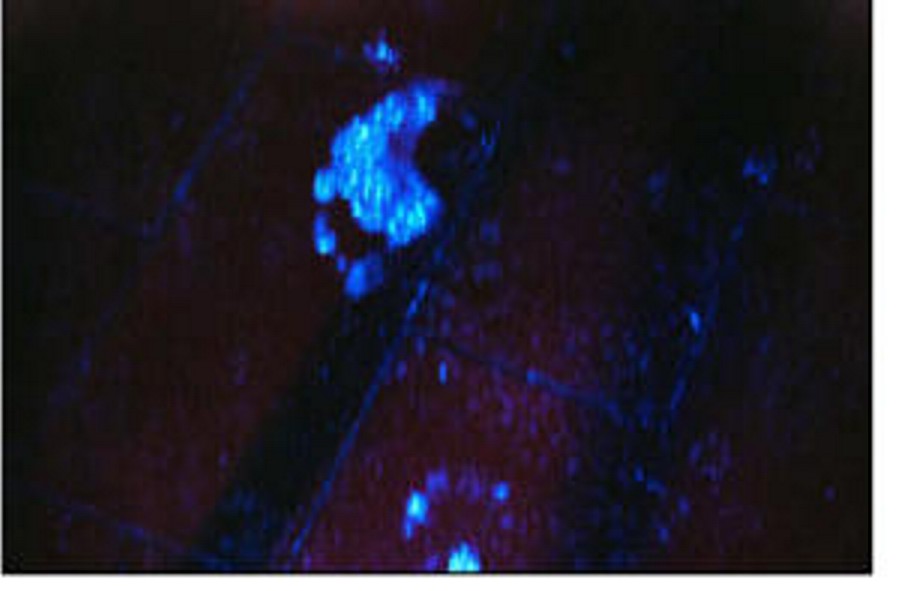
They also discovered prints in Filomena’s room which contained Meredith’s DNA and Amanda Knox’s DNA. They also revealed a footprint in Amanda Knox’s bedroom. (The defense unsuccessfully contested the investigator’s conclusions that these prints were made with blood).
On November 19 2007, an international arrest warrant was issued for Rudy Guede. He was arrested in Germany on November 20th. Guede remained in Germany until his extradition on December 3rd.
During his stay in jail in Germany, Guede wrote a long statement that was published and translated. Guede’s writings are similar to to Knox’s jail writings in many ways - they both try to write out their own detailed version of events, while pointing blame elsewhere.
But Guede’s comments may in fact be confirmation of a clean-up after the murder of Meredith Kercher (emphasis added):
I am asking myself how is it possible that Amanda could have slept in all that mess, and took a shower with all that blood in the bathroom and corridor? (Guede, Germany Diary, P21)
The police did not find evidence of any other blood until December 18th, AFTER Guede returned from Germany. As indicated above, the luminol revealed multiple footprints in the hallway, in Knox’s bedroom, and in Filomena’s bedroom. The image below shows these results in blue. Guede’s partial footprints are shown in red.
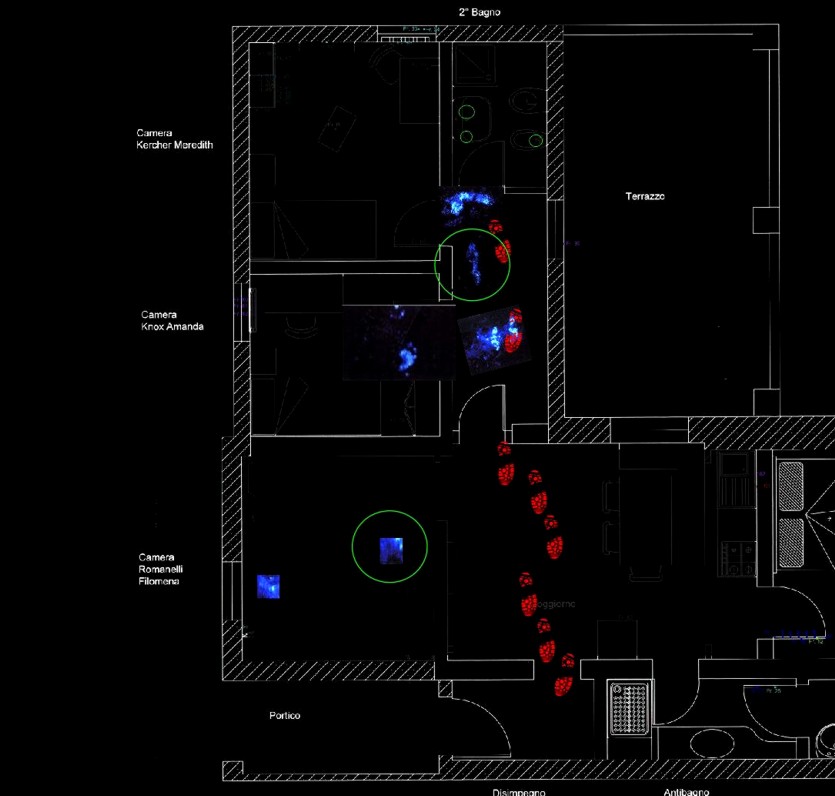
The conclusion is inescapable: Guede knew there would be significant evidence of blood in the hallway, before the police themselves found that evidence.
How did Guede know there would be more blood found in the hallway, before the police found that evidence on December 18th? And why wasn’t that blood there on the morning of November 2nd?
The courts believe the blood in the hallway was cleaned after the murder of Meredith Kercher. And the Micheli and Massei courts believed only one person had the motivation to hide this evidence: Amanda Knox.
Here is a summary of Judge Micheli’s October 2008 indictment finding.
In Judge Massei’s December 2009 trial finding for the original conviction of Knox and Sollecito, he also writes about the clean-up that the judges believed to have happened:
Further confirmation is constituted by the fact that, after Meredith’s murder, it is clear that some traces were definitely eliminated, a cleaning activity was certainly carried out. In fact, the bare foot which, stained with blood, left its footprint on the sky-blue mat in the bathroom, could only have reached that mat by taking steps which should have left other footprints on the floor, also marked out in blood just like (in fact, most likely, with even more [blood], since they were created before the footprint printed on the mat) the one found on the mat itself. Of such other very visible footprints of a bloody bare foot, on the contrary, there is no trace. (Massei, Dec 09; PMF translation)
In defense of Guede, Knox, and Sollecito, some might try to claim that Guede heard about blood in the hallway in the news. Rudy Guede was arrested 18 days following the murder of Meredith Kercher. During that time he had access to read the news and watch reports.
I have searched for articles in the period between November 2nd and December 18 which mention blood. All of the articles I have found so far discuss blood in the bedroom or the bathroom. One or two discuss footprints leading to the front door.
None of them discuss blood in the hallway that would justify a statement from Guede of “tutto quel sangue nel bagno e sul corridoghe” (all that blood in the bathroom and in the corridor)
Guede himself said he went between the bedroom and the bathroom, so may have tracked blood into the bathroom and therefore known blood would be found in the hallway.
Even that knowledge however confirms a clean-up, as there was not a trail of blood between the bathroom and Meredith’s room that justifies the footprint on the bathmat and blood found in the bathroom.
I have my own questions as a result of Guede’s knowledge of blood in the hallway:
Could the attack have started in the hallway? Could the first blood shed have been on the hallway tiles?
The prosecution and courts argue that Amanda Knox had a role in the attack and murder. Knox and her supporters are very adamant that there is no trace of Knox in Meredith’s bedroom. While the courts argue otherwise, could Knox’s role have been limited to the hallway?
Sadly, we may never know the full truth of what happened on the evening of November 1st, 2007.
My timeline of media reports on blood
- Nov 2nd: Meredith Kercher found. Blood found in bathroom.
- Nov 5th: Police analyzing traces of blood from apartment below.
- Nov 5th: A “trail of blood” is on the inside handle of the door to the apartment.
- Nov 7th: reports of Amanda Knox’s statements, includes finding blood in the bathroom.
- Nov 14th: Police use of Luminol at Sollectio’s house. First reports on the knife seized by police from Sollecito’s house.
- Nov 19th: Analysis of blood in bedroom (pillow, bra, etc).
- Nov 22nd: Guede’s prints in blood.
- Nov 27th: Amanda Knox’s blood on bathroom tap.
- Nov 28th: Blood in bathroom.
- Dec 5th: Reports of Guede’s letter to father: “there was so much blood”.
My timeline of main events involving Guede
- Nov 2nd, 2am ““ 4:30 am: Guede seen by witnesses at Domus nightclub.
- Nov 3: Guede leaves Perugia for Germany
- Nov 11: Guede’s cell phone tracked in Milan (Corriere)
- Nov 12: Newspaper reports a 4th suspect.
- Nov 19: Guede identified as suspect in newspapers
- Nov 19: Guede skype conversation with friend.
- Nov 20: Patrick released from prison.
- Nov 20: Guede arrested while trying to return to italy on train in Germany.
- Nov 21: Guede interrogated by German police; Guede admits to being at apartment, blames an italian man for murder.
- Nov 20-Dec 5: Guede writes diary in German prison.
- Dec 3: Germany grants Guede’s extradition back to Italy.
- Dec 6: Guede returns to Perugia.
- Dec 7: Guede interrogated by Magistrate.
- Dec 14: Guede ordered to remain in prison.
- Dec 17: Knox is questioned by Mignini.
- Dec 18: Police use luminol in apartment and find footprints in hallway and in Filomena’s bedroom.
Tuesday, October 08, 2013
Questions For Knox and Sollecito: Why Claim Rudy Guede Did It Alone When So Much Proof Against?
Posted by Marcello
1. Problems Of Your “Guede did it alone” Mantra
Your attempts to frame Guede for the entire attack sound racist, and they fly in the face of a multitude of hard facts.
Why are you and your more untethered supporters arguing to the media that Rudy Guede alone attacked Meredith (he could not have), that he was a drifter (he wasnt), a burglar (he wasnt), and drug dealer (he wasnt), and that his DNA traces are “all over Meredith’s room” (they werent)?
There are surprisingly few DNA traces of Guede in there, and outside Meredith’s door there is only evidence of (1) his prior use of the south bathroom, and (2) his shoeprints headed straight for the front door.
There is zero evidence that Rudy Guede was ever in the shared bathroom (the one with Sollectio’s bloody footprint on the bathmat) and zero evidence he was in Filomena’s room (the one with the broken window and the mixed DNA of Meredith and Knox).
2. Evidence Against You Is Far, Far Stronger
Explain if you can about Sollecito’s bloody footprint. Explain if you can about the evidence of cleanup. Explain this and this about your multiple contradictory alibis.
Explain if you can why YOUR own witnesses Alessi and Aviello were such disasters for your side in court. Explain your cell phone actions (or non-actions) and the timing and content of your phone calls, and your computer actions (or non actions).
Explain why in Sollecito’s book he claims he sent several emails throughout the night; but there zero records of such emails with his email provider. Explain why both Sollecito and Knox framed Dr Mignini.
There are three compelling reasons above all why the Massei court and the Supreme Court will remain totally unbending on the point that Guede did NOT attack Meredith alone, and that it had to be a pack attack on Meredith.
- One is the full day of closed court testimony at trial by crime-scene experts from Rome who accounted for every point of evidence in Meredith’s room with a depiction of a 15 minute pack attack involving three people. This seriously upset the jury and your own defense was left essentially speechless.
- One is the prosecution’s video shown in closed court during Summations of the recreation of the attack on Meredith, which accounted for every point of evidence with a 15 minute pack attack involving three people. This seriously upset the jury and your own defense was left essentially speechless .
- One is that the entry of an attacker via Filomena’s room is so absolutely unbelievable. Your own defense always knew this, and barely tried to make that sale (hence the witnesses Alessi and Aviello).
There are seven other routes for a burglar to enter the house, all of them faster and quieter and five of them darker. You can see five in these images below: two via the east windows, three up onto the balcony and into the house via the louvre door or the kitchen window.
All seven routes would be obvious to any burglar, long before he walked all the way around the base of the house to beneath Filomena’s window (which he did several times in your scenario).
3. The Numerous Questions From Which You Hide
On or after 6 November you have both promised to appear in the appeal court in Florence. You are apparently too nervous to face cross-examination under oath, but you have said you intend to try to explain things.
- 1) Rudy Guede had been to the apartment at least twice already on prior occasions and knew the boys who lived in the lower story. Why did Guede choose to NOT break-in to the lower story where he knew (or could ascertain) that all four boys were away on holiday, and therefore could break-in and rummage with some certainty of not getting caught?
2) Why did Guede choose to break-in to the upper story of the villa mid-evening, when he surely knew Knox and Kercher would be staying at the villa for the holidays and could have been there or returned at any time to “catch him in-the-act”?
3) Surely Guede would have verified that no one was present by circling the cottage and checking if any lights were on in the windows? But Guede “missed” the really easy way in: the balcony in the dark at the rear, used in 2 burglaries in 2009.
4) If Guede did circle the cottage to make sure no one was there before attempting the break-in, why would he then choose the most visible and more difficult path of entry through a second story window, as opposed to the more hidden and easier path of break-in at the back of the villa, which he would have noticed while circling the villa?
5) Why would Guede choose to break-in through a second story window that was highly exposed to the headlights of passing cars on the street as well as exposed to night lighting from the carpark?
6) Ms. Romanelli testified that she had nearly closed the exterior shutters. Assuming her memory is correct, there is no way a burglar could easily verify if the windows were latched and if the inner scuri were latched to the window panes, which would make access to the window latch impractical unless one was armed with a core drill or an ax. Why would Guede, who was certainly familiar with such windows, choose to attempt the break-in through a window that he could not easily verify would allow him quick access?
7) Assuming the shutters were closed, Guede would have to climb up the wall and open the shutters before smashing the window with the rock. The night of the murder, the grass was wet from rain the previous day. Why was there no evidence of disturbed grass or mud on the walls?
8) Guede had Nike sneakers, not rock climbing shoes. How did he manage the climb up the wall with that type of footwear?
9) If the shutters were closed, or somewhat closed, how did Guede manage to lift himself up to the sill with only an inch of sill available to grab onto?
10) Assuming Guede opened the shutters, how did Guede verify if the inner scuri where not latched to the window panes, which would prevent access to the window latch? There was no light inside Ms. Romanelli’s room to reveal that the scuri were ajar.
11) Assuming Guede managed to check that the inner scuro behind the right-hand window was not latched, how did he manage to break the glass with a 9 lb rock with one hand while hanging on to the sill with the other?
12) Assuming Guede managed check that the right-hand inner scuro was not latched, how did he break the glass with the rock without having glass shards fly into his face?
13) If Guede climbed down to the lob the 9 lb rock at the window from 3 meters below, how would he do so to avoid glass shards raining down on him?
14) If Guede climbed down to the lob the rock at the window from below, why would he choose a 9 lb 20 cm wide rock to lob up to a window 3 meters above him, with little chance of striking the window in the correct fashion?
15) If Guede climbed down again and climbed back up to the carpark (up a steep slope with slippery wet grass and weeds) to lob the 9 lb 20 cm wide rock from the car park, why is there no evidence of this second climb down on the walls?
16) Why did Guede choose a 9 lb 20 cm wide rock to throw from the car park, given that a large, heavy rock would be difficult to lob with any precision? Especially considering that the width of the glass in the window pane is only 28 cm wide, surely anyone, experienced or not, would have chosen a smaller, lighter rock to throw with greater precision.
17) If Guede lobbed a 9 lb 20 cm rock from the car park, such a lob would require some velocity and therefore force. Guede would have been roughly 11-12 feet away from the window, in order for the lob to clear the wood railing at the carpark. If the rock was thrown with some velocity, why is the upper 1/2 of the glass in the window pane intact, without any fracture cracks at all?
18) If Guede lobbed a 9 lb 20 cm rock from the car park, such a lob would require some velocity and therefore force. Why is there so little damage to the scuro the rock hit, so little damage to the terrazzo flooring impacted by the rock, and so little damage to the rock itself, which surely would have fractured more on impact with a hard terrazzo floor?
19) Why was there no evidence of glass shards found in the grass below the window?
20) If Guede climbed the wall to open the shutters, climbed down and up to the car park to throw the rock, then climbed back down and up again to the window, how does he manage to hoist himself onto the sill without cutting himself on the glass that was found on the sill?
21) If Guede climbed the wall to open the shutters, hoisted himself onto the sill, tapped the glass with a 9 lb rock to lightly break the glass in a manner more consistent with how the window was broken, why did he throw the rock into the room, rather than let it fall into the grass below?
22) Why was no dirt, grass, muddy shoeprints or similar trace evidence found on the window sill?
23) Why was no dirt, grass, muddy shoeprints or similar trace evidence found in Romanelli’s room?
24) If Guede climbed the wall to open the shutters, climbed down and up to the car park to throw the rock, then climbed back down and up again to the window again, hoisted himself onto the sill without cutting himself on the glass that was found on the sill, unlatched the window and stepped inside Filomena’s room, how did he manage to get glass on top of Romanelli’s clothing that was found under the window sill?
25) Why would Guede, who would have spent a good 10 minutes trying to break and enter with the climbing up and down from the carpark, waste valuable time throwing clothes from the closet? Why not simply open the closet doors and rifle through the clothes without creating more of mess?
26) Why did he disregard Romanelli’s laptop, which was in plain view?
27) Why did Guede check the closet before checking the drawers of the nightstand, where surely more valuable objects like jewelry would be found?
28) Why were none of the other rooms disturbed during the break-in?
29) Assuming Ms. Kercher arrived to the cottage after Guede’s break-in, presumably when Guede was in the bathroom, why did she not notice the break-in, call the police and run out of the cottage?
30) Assuming Guede was in the bathroom when Ms. Kercher returned, why go to the extent of attacking Ms. Kercher in her room rather than try to sneak out the front door, or through the window he had just broken, to avoid if not identification, at least more serious criminal charges?
31) Assuming Ms. Kercher was at the cottage while Guede broke-in, why did she not call the police the moment she heard the rock crash through the glass, loudly thud to the terrazzo floor and investigate what was happening in Romanelli’s room while Guede was climbing back down from the car park and climbing back up to the window?
32) Assuming Ms. Kercher was at the cottage while Guede broke-in, Guede could have been on the sill already because he had tapped the glass with the 9 lb rock to break it. Therefore perhaps Guede was already partially inside Romanelli’s room when he was discovered by Ms. Kercher. In this case Guede follows Ms. Kercher to her room in an attempt to dissuade her from calling the police and the assault ensues. But then, if this scenario is correct, when does Guede have time to rifle through Romanelli’s clothing and effects?
33) Why is there a luminol revealed footprint in Romanelli’s room that has mixed traces of Knox’s and Kercher’s DNA ?
34) Why does this footprint not match Guede’s foot size?
35) If multiple attackers were required to restain Ms. Kercher, holding her limbs while brandishing two knives and committing sexual violence, then who else was with Guede and why no traces of this 4th (or more) person(s) were found, either in shoeprints, footprints, fingerprints, DNA or otherwise?
36) If Guede and others were involved in the assault, why has Guede not acknolwedged them, and instead consistently hinted that, and finally admitting that Sollecito and Knox were with him during the assault?
37) If Guede and others were involved in the assault, why do the other shoeprints, footprints, DNA traces and fingerprints all point to Knox and Sollecito being present during the assault, in one way or another?
4. Italy Is Not Buying The Racist Mantra
If your racist mantra remains “the black guy did it alone” and “Italians are corrupt and stupid” you need to PROVE that. If you cannot answer all of these questions above, this will deservedly cook you.
You could be facing 30 years with the “mitigating factors” canceled and the new penalties you will incur for your dishonest books and PR campaigns.
[Five easier ways in: 3 via balcony (note two drainpipes, window grid below), 2 via side windows]
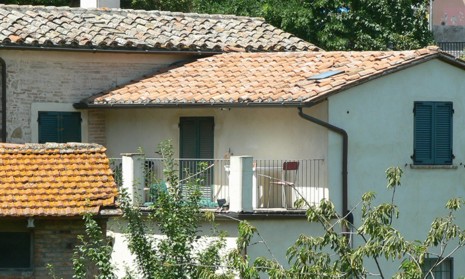
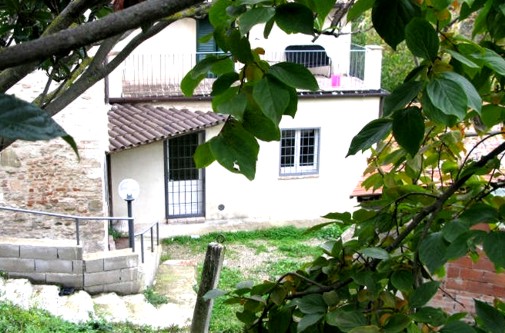
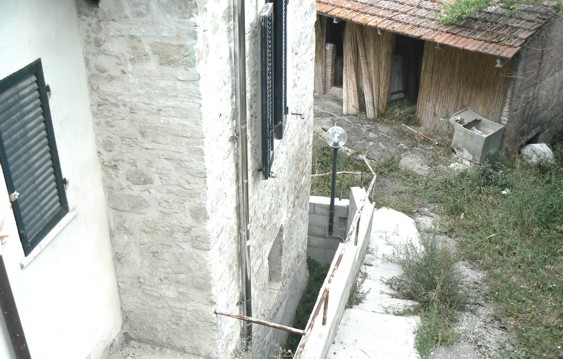
Sunday, September 22, 2013
Questions For Knox: Ten Hard Questions That Knox Should Be Asked Monday On ITV’s Daybreak
Posted by The Machine
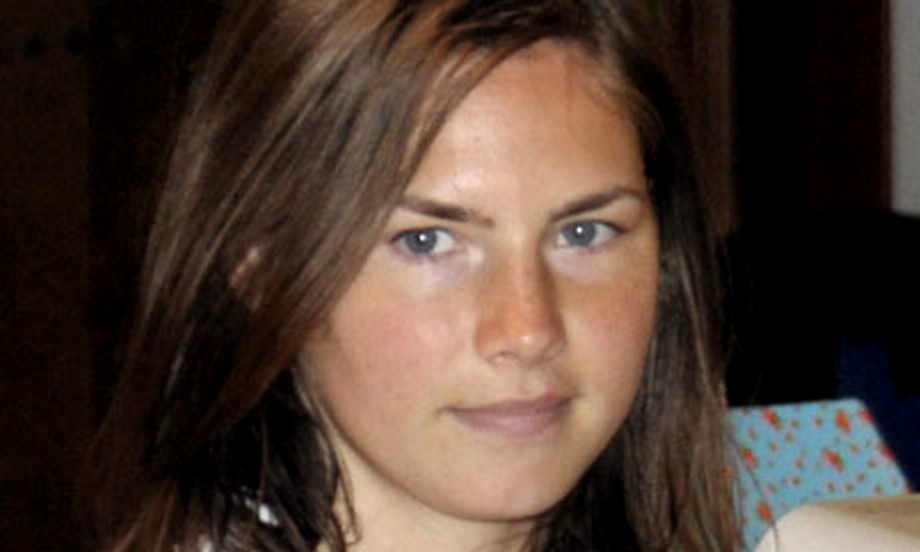
Amanda Knox will be interviewed for the first time in Britain on ITV’s Daybreak programme tomorrow.
No interviewer should unquestioningly accept everything Knox says as the gospel truth. Remember Knox served three years in prison and is labeled a convicted felon for life for malicious lying.
So let’s hope tomorrow’s interview is not yet another whiny mis-statement of the core facts, and not yet more sliming of Italian officials, of which we have just seen so many.
There are many questions on this site which Knox has never ever answered. Some arise from the evidence and some from her dishonest book.
See especially the tough questions here and here and here and here. With luck the Daybreak hosts will ask Knox all of these tough questions below.
1. Multiple false alibis
You and Raffaele Sollecito gave completely different accounts of where you were, who you were with and what you were doing on the night of the murder. Neither of you have credible alibis despite three attempts each. Sollecito told Kate Mansey from The Sunday Mirror that you and him were at a party.
He told the police that you and him were at his apartment. He then told them that he was home alone and that you weren’t at his apartment from around 9.00pm to about 1.00am. You first told the police that you were at Sollecito’s apartment. After you were informed that he was no longer providing you with an alibi, you repeatedly claimed that you went to the cottage with Diya Lumumba.
You changed your story yet again and claimed that you were at Sollecito’s apartment, but he might have gone out. All the other people who were questioned had one credible alibi that could be verified.
Extract of Sollecito’s witness statement.
“I went home, smoked a joint, and had dinner, but I don’t remember what I ate. At around eleven my father phoned me on the house phone. I remember Amanda wasn’t back yet. I surfed on the Internet for a couple of hours after my father’s phone call and I stopped only when Amanda came back, about one in the morning I think.
Question 1. Why did you and Raffaele Sollecito repeatedly tell the police and others a pack of lies?
2. False accusation
You falsely claimed that Diya Lumumba killed Meredith in two witness statements and you repeated the false accusation in your handwritten note to the police on 6 November 2007. You served three years in prison for this felony and your appeal to the Supreme Court was denied.
Question 2. Why did you repeatedly accuse Diya Lumumba of murder when you knew full well that he was completely innocent and why didn’t you or your mother retract your accusation when he was in prison?
3. The Double DNA Knife
According to a number of independent forensic experts - Dr. Patrizia Stefanoni, Dr. Renato Biondo, Professor, Giuesppe Novelli, Professor Francesca Torricelli, Luciano Garofano, Elizabeth Johnson and Greg Hampikian - Meredith’s Kercher’s DNA was found on the blade of a knife from Raffaele Sollecito’s kitchen.
He falsely claimed in his prison diary that he had accidentally pricked Meredith’s hand whilst cooking. Dr Stefanoni analysed the traces on the knife six days after last handling Meredith’s DNA. This means that contamination couldn’t have occurred in the laboratory.
Meredith had never been to Sollecito’s apartment, so contamination away from the laboratory was impossible.
Question 3. How do you think Meredith’s DNA got onto the blade of the kitchen knife?
4. The bra clasp
An abundant amount of Raffaele Sollecito’s DNA was found on Meredith’s on the exact part of Meredith bra clasp that was bent out of shape during the attack on her. His DNA was identified by two separate DNA tests. Of the 17 loci tested in the sample, Sollecito’s profile matched 17 out of 17. Professor Torricelli testified that it was unlikely the clasp was contaminated because there was a significant amount of Sollecito’s DNA on it.
Professor Novelli analysed the series of samples from all 255 items processed and found not a single instance of contamination, and ruled out as implausible that a contaminating agent could have been present just on one single result. David Balding, a Professor of Statistical Genetics at University College London, recently analysed the DNA evidence against Sollecito and concluded it was strong.
Question 4. How do you think Raffaele Sollecito’s DNA ended up on Meredith’s bra clasp?
5. The bloody footprint on the bathmat
According to two imprint experts - Rinaldi and Boemi - the bloody footprint on the blue bathmat in the bathroom matched the characteristics of Sollecito’s foot, but couldn’t possibly belong to Guede. Rudy Guede’s bloody footprints led straight out of Meredith’s room and out of the house which indicates that he didn’t go into the bathroom after Meredith had been stabbed.
See our past posts on this here and here.
Question 5. Who do you think left the bloody footprint on the bathmat?
6. Mixed samples of Amanda Knox’s DNA or blood and Meredith Kercher’s blood
According to the prosecution’s experts, there were five instances of your DNA or blood mixed with Meredith’s blood in three different locations in the cottage. Even your lawyers conceded that your blood had mingled with Meredith’s blood. In other words, Meredith and Amanda Knox were both bleeding at the same time.
Question 6. Why were you bleeding on the night of the murder and is it a coincidence that only your DNA was found mixed with Meredith’s blood?
7. The Luminol Enhanced Footprints
Bare bloody footprints were revealed by Luminol at the cottage. Three of them are compatible with your foot size and one of them is compatible with Raffaele Sollecito’s foot size.
Question 7. What do you think the Luminol was reacting to - Meredith’s blood or some other substance?
8. The staged break-in
There is absolutely no evidence that anyone stood outside Filomena’s window and climbed up the vertical wall on the night of the murder. There were no marks from soil, grass or rubber soles on the wall. The earth of the evening of 1 November 2007 was very wet, so if anybody had climbed the wall, they would have left some marks on it.
The glass on the window sill and on the floor show no signs of being touched after the window was broken, which would have been the case if the intruder had gained entry through the window.
There was not a single biological trace on any of the shards of glass. It would have been very likely that an intruder balancing on the window sill would have suffered some kind of injury or cut because of the shards of glass.
If the window had been broken from the outside, there would have been shards of glass outside, but there wasn’t even one.
Judge Massei and the panel of judges at the Italian Supreme Court specifically mentioned the shards of glass on top of Filomena’s clothes which had been tossed onto the floor in her room and regarded it as proof that the break-in was staged.
Question 8. Who do you think staged the break-in at the cottage?
9. Knowledge of the crime
Umbria Procurator General Galati’s pointed out in his appeal that you knew specific details of the crime that you could have only known if you had been present when Meredith was killed.
According to multiple witnesses at the police station, you said you were the one who had found Meredith’s body, that she was in the wardrobe, that she was covered by the quilt, that a foot was sticking out, that they had cut her throat and that there was blood everywhere. But you weren’t in a position to have seen anything at all when the door was kicked in.
In your witness statement you described Meredith’s scream. Other witnesses have corroborated your claim that there was a loud scream.
Question 9. How did you know so many precise details of the crime?
10. Shower and the “bathmat shuffle”
The Scientific Police found 13 traces of blood in the bathroom that Meredith and you shared. Prosecutor Mignini and Filomena have both expressed their surprise that you showered in a blood-spattered bathroom.
Filomena told Mignini during cross-examination: “I thought it was odd that she’d had a shower when there was blood all over the place.”
You told Mignini that you used the bathmat to shuffle to your room.
Question 10. Why did you shower in a bathroom that was splattered with blood, and did you notice the visible bloody footprint on the bathmat when you used it to shuffle to your room? And why so soon after did the police notice that you were stinking?
Lorraine Kelly and Aled Jones the ITV Daybreak hosts who should confront Amanda Knox

Wednesday, July 24, 2013
How The Clean-Up And The Locked Door Contribute To The Very Strong Case For Guilt
Posted by James Raper
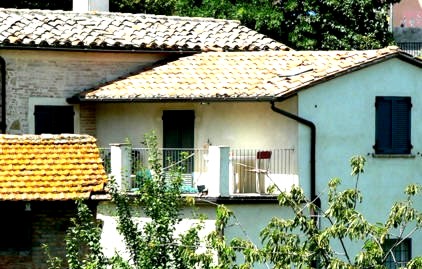
On the 30th September the appeals of Amanda Knox and Raffele Sollecito against the convictions they received at the first instance trial will resume, this time in Florence.
This follows the annulment by the Supreme Court of the acquittal verdicts rendered by the Appeal Court presided over by Judge Pratillo Hellmann. There is one conviction not under appeal. This is Knox’s conviction for calunnia, which is now definite.
They are therefore both currently convicted of murder and sexual assault, and a number of lesser charges, amongst which there is the simulation of a burglary “to ensure impunity for themselves from the felonies of murder and sexual assault, attempting to attribute the responsibility for them to persons unknown who penetrated the apartment to this end”.
There is one activity, for which there is evidence, with which they were not charged (perhaps either because it was redundant or not a criminal offence) though this was likewise to ensure impunity for themselves.
This is the partial clean up at the cottage and it is this with which I intend to deal. I want to highlight salient observations which have been under discussion here and elsewhere and some of which may be well known to readers, but perhaps some not, or have been forgotten about. Once again, in many cases, I am merely a conduit for the observations of others, not least the first instance trial judge Giancarlo Massei.
So let”˜s consider the observations and in doing so we can also throw some more light on the lone wolf theory.
1. Take a look at the bloody footprint
This is, of course, the bloody footprint on the bathmat in the small bathroom right next to Meredith’s room.
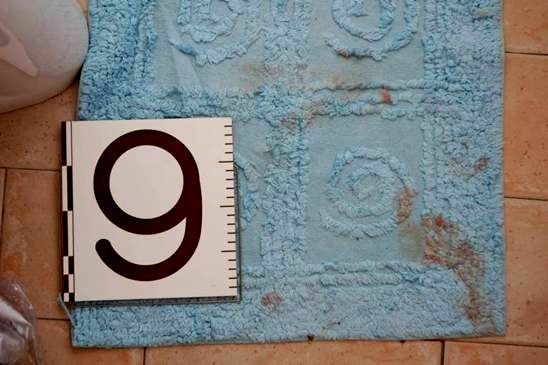
The heel of the right foot, if it had blood on it, is missing from where it should be on the tiled floor. It is difficult to imagine, given that the imprint of the foot on the mat is contiguous with the edge of the mat, that there was not at least some blood on the remainder of the foot such that there must have been at least some blood deposited on the floor.
Just as difficult to imagine that casual shuffling about on the bathmat would have removed the blood so as to render it “invisible” to the use of luminol.
Of equal relevance is that there were no connecting bloody footprints. Why not?
The defences have an improbable theory - that Guede, despite his homicidal rage, was smart enough to hop about on his left foot with a clean shoe on, and the other bare but covered in blood, and that having by this means entered the bathroom and washed his bloody right foot, disastrously leaving his (supposed) imprint there in the process, he then returned to Meredith’s bedroom inadvertently standing in blood with his left shoe and leaving with a trail of bloody left shoe prints - in which case the exercise of washing his foot was entirely in vain, on two counts, after all that careful hopping around.
Neither is it entirely clear why his right shoe came off in the first place.
It is far more probable that the inevitable bloody prints were deliberately and carefully removed. The reason for doing this was not just to conceal who would have made them (the print on the bathmat was, after all, left in situ) but, from a visual perspective, to conceal any blood that might be noticeable and alarming to anyone approaching Meredith’s room. Guede’s bloody shoeprints in the corridor were visible but only on close inspection.
2. Take a look at the bathroom door
Specifically the internal (hinge) side of the bathroom door. Take a look at this photograph.
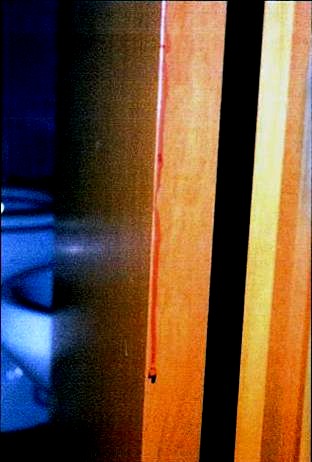
We see a long streak of dried blood. Clearly the blood has flowed some distance under the influence of gravity and we can see that it looks slightly diluted, with red corpuscles gathering towards the tip of the streak. A drip of that size does not appear from nowhere.
Indeed it is difficult to imagine how the blood got there unless it was part of a larger area of blood which most likely was on the face of the door and which was swiped to the right and over the edge of the face of the door. The cloth or towel used to do this was wet accounting for the slight dilution and length of the streak.
3. Take a look at Meredith’s door
It is interesting, is it not, that there is blood on the inside but not on the outside? The outside:
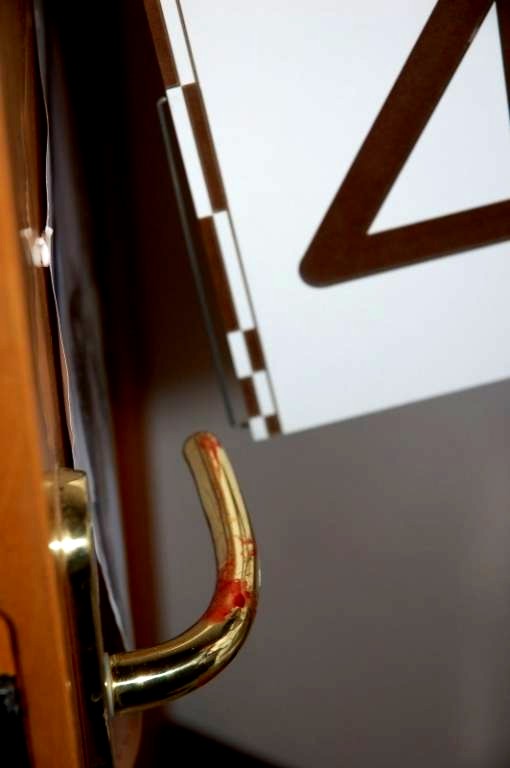
It is difficult to see how and why Guede touched the inside handle with a bloody hand (was it shut and if so, why?) and then closed the door to lock it without leaving a trace on the outside face of the door. Possibly he might have changed hands. The answer might also be that he visited the bathroom to wash his hand as well as his foot, save that none of his DNA was recovered from the spots and streaks of diluted blood in the washbasin, whereas Knox’s DNA was. All the more surprising given that Guede shed his DNA in Meredith’s room.
We see some blood on the edge of the door which again might be the remnant of a trace on the outside face.
4. Take a look at Amanda Knox’s lamp.
This was found inside Meredith’s room behind the door. Meredith also had a similar lamp which was resting on it’s base on the floor by her bedside table.
The presence and location of Knox’s lamp is obviously suspicious. Had Meredith borrowed Amanda’s lamp because her own was not working, then it would not have been in the position it was found but on or more likely knocked over and lying beside the bedside table since the violence appears to have been concentrated in that area of the room.
Had Meredith’s lamp been on the bedside table then likewise it too would most likely have been knocked over in her life and death struggle with her sole assailant (there are blood streaks on the wall just above) and it would not have ended up sitting upright on it’s base.
Both lamps were probably used to check the floor of Meredith’s room after the event and Knox’s lamp was probably sitting upright until it was knocked over by the door being forced open.
This is Meredith’s lamp by the bedside table.
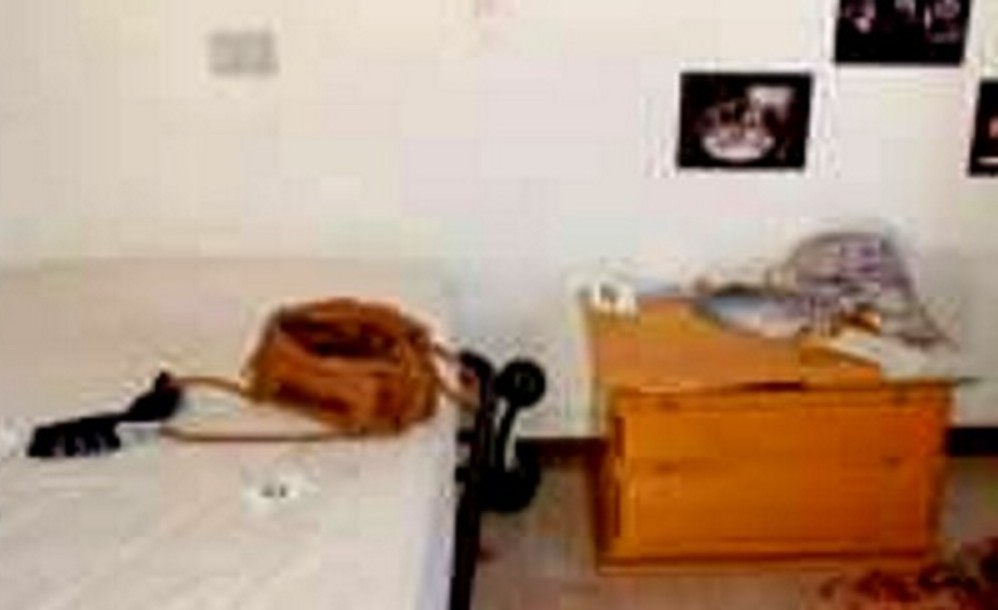
And this is Knox’s lamp by the foot of the bed.
5. Take a look at what luminol revealed
We can state with confidence that luminol (extremely sensitive to and typically used to identify blood that has been wiped or washed away) discovered :-
(a) three bare footprint attributable to Knox, one in her bedroom and two in the corridor, and
(b) two instances of the mixed DNA of Meredith and Knox, one in Filomena’s bedroom and one in the corridor.
(c) a footprint attributed to Sollecito in the corridor.
I have covered a number of elements strongly suggesting that there was at least a partial clean up, not of “invisible DNA” as the Groupies like to mock, but of what would have probably in some cases have been noticeable deposits of blood that would have attracted the eye of anyone entering the cottage and which would certainly have alarmed the observer as being difficult to explain.
Spots of and footprints in blood, not just in the bathroom but outside it, a locked bedroom door with blood on it, and a bathroom door with blood on it’s face.
We can include Knox as one such observer given her e-mail account of having allegedly stopped by the cottage to have a shower and collect some clothing before the discovery of the body. Such physical evidence - had it not been removed - would not have sat easy with that account, however dizzy and naïve Knox presents herself. One can envisage Knox thinking “sorted” - that her story would now work perfectly.
Even so, there were elements that were overlooked, such as Knox’s blood on the washbasin faucet and blood generally in the small bathroom, but a door can be closed and at least these were elements amenable to some form of explanation from her perspective, whether or not convincing, as occurred in the e-mail.
Incidentally in addition to the mixed traces in the small bathroom, Meredith’s blood was found on the light switch and a cotton bud box. I have a hard time imagining what Guede would have wanted with the cotton bud box, less so Amanda given her blood on the faucet, ear piercings and a scratch on her throat. Knox, when asked during her trial, could not recall having switched on the light during her alleged visit to the cottage.
6. Take a look at the items on Knox’s bed
Massei concluded that it was likely that it was Knox who carried out the clean up, which if correct might explain why it was not central to her thinking to dispose of the bathmat with Sollecito’s bloody footprint on it!
Knox was seen by Quintavalle at his store at 7.45 am on the 2nd November, thereby destroying her alibi. He described her as pale faced, exhausted looking, with pale blue eyes. He also added, and he would not have known this from photographs in the newspapers, that she was wearing blue jeans, a grey coat and a scarf, with a hat or cap of some sort.
We can see from the crime scene picture of Knox’s bedroom below, that such items (minus hat or cap) appear to be lying on her bed.
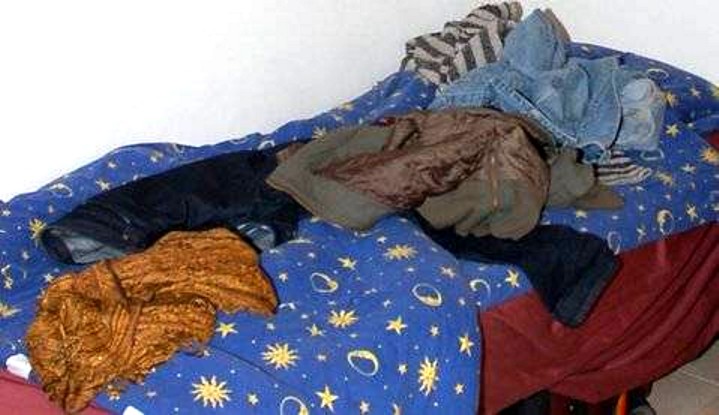
Sollecito did not accompany Knox to the store but this would be because he was known to Quintavalle whereas he was unfamiliar with her. He may however have accompanied Knox to the cottage and/or have acted as look out for her when she was there.
7. Some conclusions
I have included “The locked room” in the title because of a poster’s observation regarding Guede’s bloody left shoeprints exiting Meredith’s room. There is the simple observation that these footprints are going one way only and not towards the small bathroom. But they do not even turn to face Meredith’s door, and again hard to imagine that this could be so if it was Guede who locked her door!
We can rule out Guede as having been involved in any aspect of the clean up precisely because of that trail of footprints and other evidence of his presence left behind.
Now that the travesty of the Hellmann acquittals has been truly exposed Knox and Sollecito face an impossible uphill task.
The clean up and the locked door are just two of many elements in this case which combine together and corroborate each other in a manner that enables us to see the truth beyond a reasonable doubt.
Friday, April 19, 2013
Twenty Forensic Reasons Why Guede Could NOT Have Attacked Meredith Alone
Posted by Cardiol MD
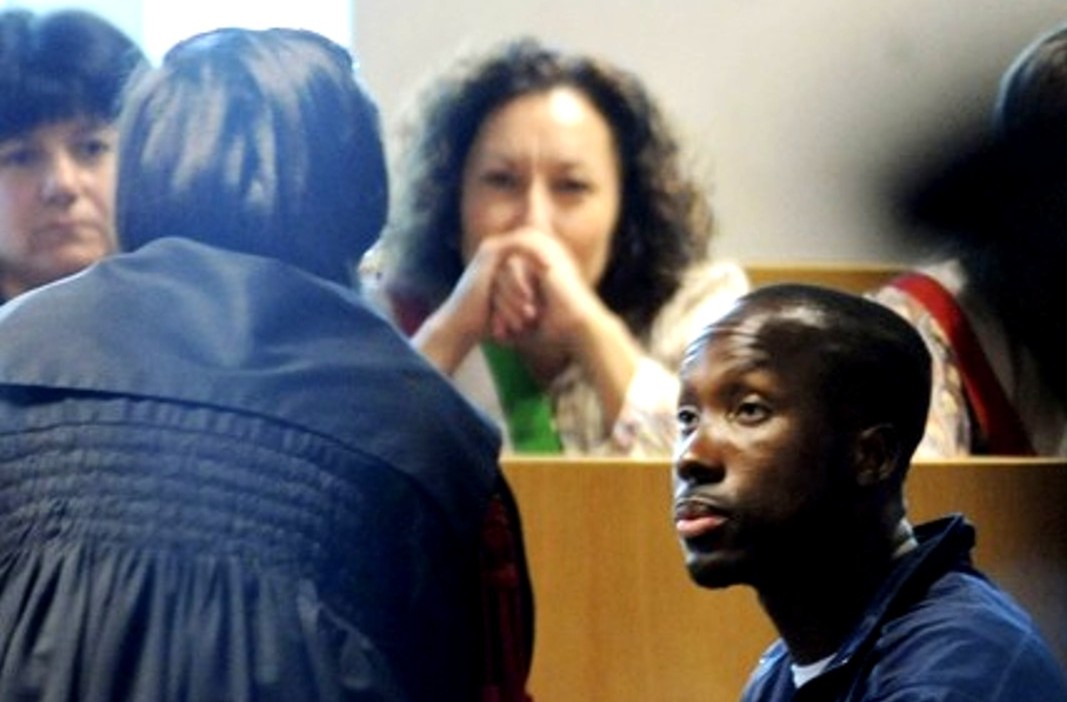
[Bongiorno in 2011 trying to rattle an unshakable Guede claiming Knox and Sollecito did the crime]
1. Guede Persona, An Overview
The convicted murderer Rudy Guede to this day claims that Meredith let him into the house, so we cut him no slack for that.
But at the same time he was no drifter or serial knife carrier, he had no police record in 2007 (unlike Knox and Sollecito), and no drug dealing or breaking-and-entering has ever been either charged or proved.
In October 2008 Judge Micheli mistrusted and sharply rebuked a witness who claimed it just might have been Guede who broke into his house.
Guede seriously discounted his role on the night of Meredith’s death, but some physical evidence (not a lot) proved he had played a part in the attack. Thereafter his shoeprints lead straight to the front door.
2. Moving Target In Court
Neither Judge Micheli nor Judge Massei nor the Supreme Court believed he acted alone or had any part in the very obvious cleanup that had been carried out.
The Knox and Sollecito defenses failed miserably to prove he climbed in Filomena’s window, and despite much innuendo they never really tried to prove he was a lone attacker.
That is why in 2011 we saw two of the most bizarre defence witnesses in recent Italian legal history, the jailbirds Alessi and Aviello, take the stand
Alessi became so nervous making his perjured claim that Guede told him Guede did it with two others that he was physically sick and had to take time off from the stand.
Aviello loudly proclaimed that his brother and another did it (not Guede) and then claimed the Sollecito family via Giulia Bongiorno floated bribes in his prison for false testimony.
Tellingly, although Bongiorno threatened to sue Aviello, she never has. Even more tellingly, Judge Hellmann himself initiated no investigation and simply let this serious felony claim drop dead.
Here is a far-from-exhaustive list of 20 reasons why Rudy Guede could not have acted alone. Also why not one scrap of evidence has ever been found for any two other than Knox and Sollecito themselves.
3. Twenty Lone-Wolf Disproofs
1. Guede’s Final Appeal Report said Meredith sustained 43 wounds
The testimony at the 2009 trial about the 43 wounds was presented in closed court out of humane respect by the jury for the feelings of Meredith’s family.
So even the diligent and trustworthy Italian media mostly missed this, as they were locked outside.
Mention of the 43 wounds was omitted from the 2009 Massei Trial Report and also from the 2011 Hellman Appeal Report.
Its inclusion in the December 2010 in Judge Giordano’s Supreme Court report on Guede’s final appeal reflects the report’s excellent factual completeness.
The PMF translation reads, in relevant part:
The body presented a very large number of bruising and superficial wounds – around 43 counting those caused by her falling – some due to a pointed and cutting weapon, others to strong pressure: on the limbs, the mouth, the nose, the left cheek, and some superficial grazing on the lower neck, a wound on the left hand, several superficial knife wounds or defence wounds on the palm and thumb of the right hand, bruises on the right elbow and forearm, ecchymosis on the lower limbs, on the front and inside of the left thigh, on the middle part of the right leg, and a deep knife wound which completely cut through the upper right thyroid artery fracturing the hyoid bone, a wound which caused a great deal of bleeding.
Including the number of minutes occupied by an initial verbal confrontation, the escalation of that confrontation into taunting and then the physical attack, leading to the infliction of 43 wounds, and to the fatal stabbing, how many minutes would all of this occupied?
The prosecution estimated it took fifteen.
2. Meredith had taken dance classes and played football & karate)
See the Massei Translation, p23.
Every day Meredith called her family, with whom she had a very close relationship. She had taken classes in dance and played sports (football, karate); she was a strong girl, both physically and in terms of temperament (cf. statements by her mother and by her sister Stephanie, hearing of June 6, 2009).
3. Meredith was a strong girl, physically and in temperament
See the statements by her mother and by her sister Stephanie (hearing of June 6, 2009). and description of her karate. (Massei Translation, pp23, 164, 366, and 369).
With regard to the totality of these circumstances, it must be considered that Meredith could only have made an outright refusal to Rudy’s advances and in doing so could also count on her slim [fit] physique, which the photos allow [one] to understand, [and] on her good athletic training (other than dance she had also done sports characterised by a certain physicality such as football, and had even taken a course in karate), sustained by her strong character.
4. Meredith must have been “strongly restrained”
See the Massei Translation, p371; p399, in the Italian original.
Conversely, considering the neck wounds sustained, it must be believed that Meredith remained in the same position, in a standing position, while continuously exposing her neck to the action of the person striking her now on the right and now on the left. Such a situation seems inexplicable if one does not accept the presence of more than one attacker who, holding the girl, strongly restrained her movements and struck her on the right and on the left because of the position of each of the attackers with respect to her, by which it was easier to strike her from that 372 side. One of these attackers was Rudy and the others were those who allowed Rudy to enter the house and who were with him in the house and who, in order to lead the nvestigations astray, then organised the staging of the broken window and the mess in Romanelli’s room: Amanda Knox and Raffaele Sollecito, according to all that has already been shown.
5. Meredith remained virtually motionless throughout the attack
That was in spite of Meredith’s physical and personality characteristics [Massei Translation p369] [Massei Translation p370-371].
A first indication to be taken into account is Meredith’s physical build: the photographs of her body and the data of her approximate height and weight reveal a physique with “normotrophic muscular mass and normally distributed subcutaneous fat” (cf. declarations Lalli p. 3), a slim physique which would have permitted Meredith to move with agility. To this must be added the declarations of the parents and the sister of Meredith. Her mother, Arline Carol Mary Kercher, recalled that Meredith had practised football and karate (p. 7 hearing 6 June 2009), and her sister, Stephanie Arline Lara, stated that Meredith also did boxing, if only the once, and that “physically she was very strong” (p. 20, hearing 6 June 2009). Also her father, John Leslie Kercher, declared that his daughter was quite strong and had taken a course in karate (p. 23 hearing 6 June 2009). It has also been noted that Meredith was not in bed and undressed when the “advances” and the attempts to subject her will commenced. Being still dressed and awake, and since it must be excluded because of what has been said above that the violent action could have taken place with Meredith lying on the bed, it is considered that she, who was sober and fully conscious since no traces indicating either the use of drugs or the abuse of alcohol were found, would have opposed a firm resistance, as she could claim a strong physique, experienced in self-defence by the lessons in karate that she had taken.
6. The defensive wounds were almost non-existent
See the report of Dr Lalli, pp. 33, 34, 35 with the relevant photos. Massei Translation p370.
The signs of this resistance, however, consist in a scream, the scream heard by Nara Capezzali at around around 23:30 and by Maria Ilaria Dramis when, having gone to bed at 22:00 pm, she awoke at a later time which she was not able to quantify; they consist also in some tiny defensive wounds: one on the palm of her [396] right hand of a length of .6cm showing a tiny amount of blood; another on the ulnar surface of the first phalange of the second finger of the left hand, also of length .6cm; another on the fingertip of the first finger with a 370 superficial wound of .3cm, and another tiny wound corresponding to the fourth radius. Compared with these almost nonexistent defensive wounds (cf. report of Dr Lalli, pp. 33, 34, 35 with the relevant photos), there is an injured area which is impressive by the number, distribution and diversity, specifically of the injuries (bruises and wounds) on the face and neck of Meredith.
7. One killer couldn’t inflict 43 wounds with so few defensive wounds.
See the Massei Report quotes above.
8. There must necessarily have been two knives at the scene of the crime
See the Massei Translation p377.
Even this consideration, therefore, leads one to hold that the biological trace attributable to Amanda and found on the knife handle, could have derived from the use of the knife for the purpose of striking, rather than to cut food; it could have derived, therefore, from the harmful action carried out against Meredith and as a consequence, a biological trace attributable to Meredith remained in the tiny striations present on the face of the blade, in spite of the subsequent cleaning, and which does not appear otherwise explainable as to how, in this regard, it was to be found there (Meredith had never been in Raffaele Sollecito’s house and could never have used this knife). Moreover, the knife Raffaele Sollecito carried with him had a definitely shorter blade as has been seen than the length that would have been necessary for causing the deeper resulting wound, with a depth of 8cm, and therefore, there must necessarily have been two knives at the scene of the crime, first one, and then the other, being used against Meredith.
9. A lone killer would need one hand/arm or both to restrain Meredith
So how could he use 2 knives? To use 2 knives a lone killer would have to place 1 knife down, leaving blood-stain[s] wherever it was placed, and then reach for the other knife.
Even wiping the blades on the killer’s clothes, using the one hand, and later scrubbing of the knives would not erase all the blood, as has already been demonstrated.
10. Two killers could divide attack, one holding Meredith, both holding knives
Meanwhile the other killer used one hand/arm to restrain Meredith, and the other hand to use the various knives. Could a lone killer accomplish all that?
11. Meredith’s shoes, pants and underwear had been removed
See the Massei Translation p.370
“It is impossible to imagine in what way a single person could have removed the clothes that Meredith was wearing (shoes, pants and underwear), and using the violence revealed by the vaginal swab, could have caused the resulting bruises and wounds recalled above, as well as removing her sweatshirt, pulling up her shirt, forcing the bra hooks before tearing and cutting the bra.” [Massei Translation p.370]
12. Meredith’s sweatshirt had been pulled up and removed.
See the [Massei Translation p.370
Furthermore, it is impossible to imagine in what way a single person could have removed the clothes that Meredith was wearing (shoes, pants and underwear), and using the violence revealed by the vaginal swab, could have caused the resulting bruises and wounds recalled above, as well as removing her sweatshirt, pulling up her shirt, forcing the bra hooks before tearing and cutting the bra.
13. Meredith’s bra had been forcibly unhooked
See the Massei Translation p.370
14. Meredith’s bra had been torn
See the Massei Translation p.370
15. Meredith’s bra had been cut
See the Massei Translation p.370
16. Violence to Meredith was revealed by the genital swab.
See the Massei Translation p.370
17. In Hellmann appeal RS’s lawyers didnt allege lone killer
They themselves brazenly introduced false testimony to the effect that there were two other killers.
18. Even Hellmann didn’t deny the complicity of AK and RS
Even H/Z seemed to conclude they are probably guilty, but not beyond a reasonable doubt:
“| in order to return a guilty verdict, it is not sufficient that the probability of the prosecution hypothesis to be greater than that of the defence hypothesis, not even when it is considerably greater, but [rather] it is necessary that every explanation other than the prosecution hypothesis not be plausible at all, according to a criterion of reasonability. In all other cases, the acquittal of the defendant is required.” [H/Z p.92]
19. Judge Micheli, in Guede’s trial, found that Guede did not act alone
And that the evidence implicated Amanda Knox and Raffaele Sollecito as accomplices of Rudy Guede in the murder of Meredith Kercher.
20. Massei found that the evidence implicated AK and RS
He concluded they were joint perpetrators with Rudy Guede in the murder of Meredith Kercher.
4. Obvious Conclusions
Is it really reasonable to claim as Sollecito did in his 2012 book that Guede was a lone killer?
Doesn’t all this contradict the lone-killer theory, beyond a reasonable doubt?

